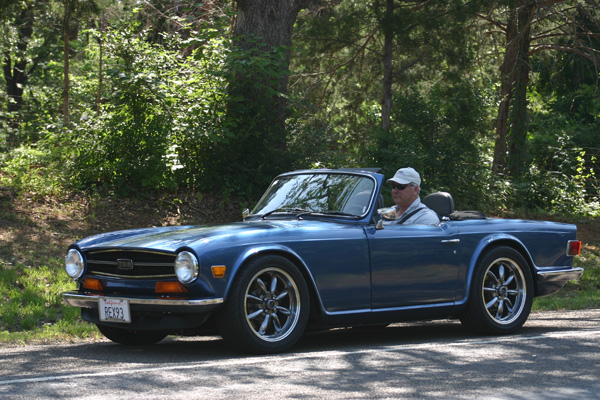
Calvin Grannis' Chevy LS1 V8 powered 1974 Triumph TR6
as published in BritishV8 Magazine, Volume XX Issue 1, July 2012
Owner: Calvin and Brenda Grannis
BritishV8 UserID: 74ls1tr6
City: Elk Grove, California
Model: 1974 (April) Triumph TR6
Engine: 2002 Chevrolet LS1 5.7L (EFI)
Conversion performed by: owner
Today's Triumph
Calvin Grannis' interest in British sports cars started in his high school years,
in the late 1970s, with a 1968 Triumph TR250. The TR250 model was the American-market
equivalent of Triumph's TR5 model. The two featured similar specs, except the TR250
came with twin Stromberg carbs in lieu of fuel injection. Those carburetors restricted
power, and with them the 2.5L six cylinder engine was only rated 111 brake horsepower.
Calvin wasn't content with that, so he carefully balanced the engine's internals to support
high RPM use. Next, he boldly shaved the cylinder head an aggressive 0.087" for a dramatic
increase in compression ratio. Finally, he put the engine together with triple Weber carburetors.
The combined effect was a Triumph that could keep up with almost any stock Mustang or Camaro
to the edge of town, then outbrake and pass them in the twisties. A fancy highly-polished
lacquer paint job completed the project.
Fast forward to 2007, when Calvin discovered the BritishV8 website and its message board.
Calvin says our website inspired him to build another Triumph: similar fun, but updated to
meet all of today's performance expectations. Smooth. Comfortable. Confidence inspiring.
Calvin chose to use a Chevrolet LS1 engine and a T56 six speed transmission from a 2002
Chevrolet Camaro Z28, but he didn't stop there. His 1974 Triumph TR6 represents a complete
and coherent vision. It seems that every aspect of the car has been updated, and that a
careful balance has been struck. No single thing stands out as "too much."
The most understated thing about Calvin's TR6 is its exterior bodywork. Its "ghost stripes"
are so subtle that from some angles you might wonder if you're imagining them. You might
or might not notice the whopping huge dual Monza glass-pack exhaust tips that peak out
from under the Kamm tail. You might just barely catch a glimpse of the Wilwood brake calipers
through the wheels. Okay... I'll concede that the seventeen inch wheels would be hard
for anyone to miss, but they're obviously Minilite inspired. Wrapped around all that though,
I'd challenge any casual observer to identify a detail of the exterior sheetmetal that doesn't
look bone stock. My personal impression is that this car is nothing if not subtle.
Until someone pushes the loud pedal to the floor! As the car accelerates, the skin of your
face gets really tight against your cheekbones. The skin behind your ears starts to flap
excitedly in the wind. Fighting such great g-force, you can't keep your mouth closed. I've
been in cars that made me smile, but never in this particular way. (Meanwhile, I was
thinking: "Uh. Ummm. Calvin? I forgot my helmet...")
Calvin and Brenda celebrated the triumphant completion of their project by making the
2000 mile round-trip trek to attend BritishV8 2012, and that's where I got to experience
their LS1 powered TR6 in person. Four hundred brake horsepower in a Triumph TR6 is indeed
impressive. But Calvin Grannis is as cool as a cucumber. He thinks he's just tooling around.
This is a Sunday drive to him, and we're taking things easy. Indeed we are. But Standards
have changed. This isn't yesteryear's hot-rod - it's faster but it's much more refined - it's
Today's Triumph.
Features and Specifications
| Engine: | Chevrolet LS1 V8 engine from a 2002 Camaro Z28.
(The engine came standard with aluminum block and cylinder heads,
electronic fuel injection,
coil-on-plug electronic ignition,
and six-bolt main bearing caps.
5.7L equals 346ci.)
Texas Speed & Performance (TSP) / Precision Race Components (PRC) LS6-style cylinder heads.
62cc combustion chambers.
10.8:1 static compression ratio.
CNC-ported and fitted with oversized valves (2.02" intake and 1.575" exhaust).
Dual 0.650" lift valve springs.
Chromaloy push rods.
LS2 timing chain and gears.
FAST 90mm intake, hand ported by Tony Mamo from AFR.
90mm throttle body from Nick Williams.
K&N gauze air filter.
Ported LS6 oil pump.
Stock 28# fuel injectors (for now).
TSP-sourced Comp Cams camshaft (228° duration, 0.588" lift, 112° lobe separation angle.)
Stock rocker arms with Comp Cams sealed-needle bearing trunion upgrade.
LS7 lifters.
Stock PCM, tuned with HP Tuners software.
Street & Performance Front Runner accessory bracket / pulley / serpentine belt drive system.
|
| Cooling: | Griffin aluminum crossflow radiator (24" x 19" x 3") with 2-row (1.25" tube) core.
16" 2250cfm electric fan with matching shroud. |
| Exhaust: | Hooker Super Competition four-into-one headers with 1.625" diameter primaries.
2.5" pipes.
Magnaflow X-pipe mounted inside the frame.
Dual 2.5" Borla Pro XS mufflers.
Monza 2.5"-to-4" glass-pack exhaust tips. |
| Transmission: | Tremec T56 6-speed with normal F-body gearing.
(6th gear: 1700rpm at 70mph & 2000rpm at 80mph. Great for gas mileage!)
Fidanza 12.5 pound aluminum flywheel with changable clutch surface.
SPEC Stage 2+ pressure plate and clutch disc.
Stock TR6 master cylinder.
Stainless steel braided line.
Chevy Camaro 3" aluminum prop shaft, shortened to 25".
(Camaro-spec U-joint at transmission. Nissan Infiniti Q45 U-joint at differential.)
Street & Performance Inc. gear shifter ("shifter handle relocator").
Ford Mustang shifter knob, reamed out to fit. |
| Rear End: | Nissan Infiniti Q45 (R200) viscous limited-slip differential and 3.54:1 final drive ratio.
Good Parts constant velocity joint axles and uprated hubs. |
| Front Suspension: | quick ratio steering rack.
Woodward Precision Power Steering universal joints.
Uncle Jack's uprated spindles.
Good Parts lowering springs.
Spax adjustable shock absorbers.
Nylatron bushings.
Good Parts anti-sway bar. |
| Rear Suspension: | Good Parts 600#/inch lowering springs.
Roadster Factory coilover conversion kit, featuring AVO shock absorbers.
Good Parts adjustable anti-sway bar, re-located rearward.
Good Parts adjustable trailing arm attachment brackets and Nylatron bushings.
Rear trailing arms upgraded from 5/16" to 3/8" studs, with Helicoil inserts.
|
| Brakes: | (master) Wilwood 1.125" tandem master cylinder. Wilwood proportioning valve on rear circuit. (front) Wilwood 4-pot calipers and 12.19" rotors. Custom aluminum hats. Stainless braided lines. (rear) '97 Nissan Maxima calipers on Don Watson brackets. '92 Nissan 240SX rotors and e-brake cables. |
| Wheels/Tires: | Rota RB Hyper Black aluminum wheels (17x7.5, 4-100mm lug spacing, +45mm offset).
Yokohama S-drive w-rated 245/45R17 tires (~10" wide).
One inch spacers/adapters to convert from 4-4.25 hubs to 4-100mm wheels. |
| Electrical: | Advance Auto-Wire wiring harness.
Stinger distribution block and main fuse.
Odyssey Extreme Racing (ER40, nine pound) battery, mounted in trunk.
140 amp Delco style alternator, with polished finish.
LED rear running and brake lights. |
| Interior Mods: | custom dashboard made from Kewazinga African rosewood by Randy Keller / Prestige Autowood.
AutoMeter Phantom II digital gauges (set of 7).
Leather wrapped Moto-Lita steering wheel.
Early-style Mazda Miata seats, with upgraded speakers in headrests.
Upper and lower electric seat heaters.
SPAL power windows, installed with four-pin contact strips at door jams.
Vintage Air Mini Air/Heat/Defrost, with controls in center panel.
(Sanden 508 a/c compressor.)
LED footbox lighting, both sides.
Wool carpet. |
| Chassis Mods: | welded metal plate in front lower suspension attachment areas.
Plates were welded-in on top of frame under outer footwell area.
1" steel tube welded in between frame rails by the transmission mount.
Re-welded transmission mounting area for enhanced strength.
Added reinforcement around rear suspension area (i.e. both tower sections.)
Tied both rear suspension towers together with 1" steel tube.
Moved front sway bar to above skid pan and extended front frame to strengthen sway bar attachment points.
|
| Body Mods: | no sheetmetal modifications on the outside of the car.
PPG Atlantic Pearl Blue two stage paint with white pearl ghost stripes.
Lizard Skin sound and heat control products. |
| Fuel System: | Racers Choice Inc. 19 gallon aluminum fuel tank.
Aeromotive inline fuel pump.
Corvette fuel filter / regulator. |
| Performance: | 28mpg highway, 25mph city.
0 to 60 in ~3.5s.
~408 horsepower from 5800 through 6100rpm and
~390ft-lbs torque from 4500 through 5200rpm
at the wheels. |
| Completed: | road-worthy in April 2011. (First engine start on June 17, 2009.) |
Engine Installation
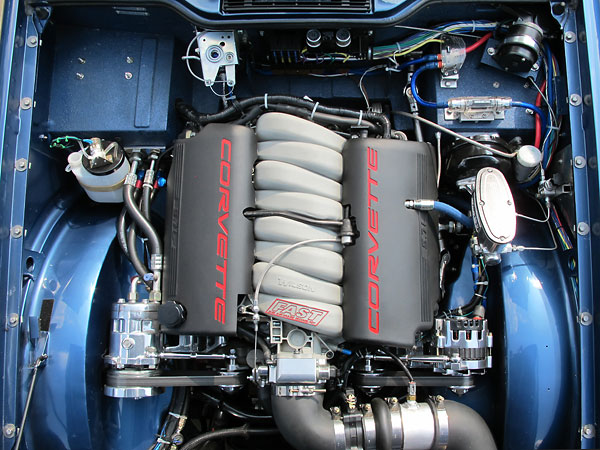
Chevrolet LS1 V8 engine: 350 cubic inches, aluminum engine block and cylinder heads,
six-bolt main bearing caps, electronic fuel injection, and coil-on-plug ignition.
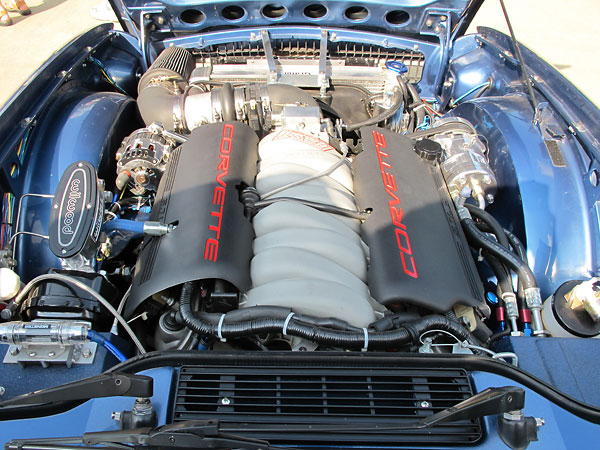
At the wheels? 408 horsepower from 5800 to 6100rpm. 390ft-lbs from 4500 to 5200rpm.
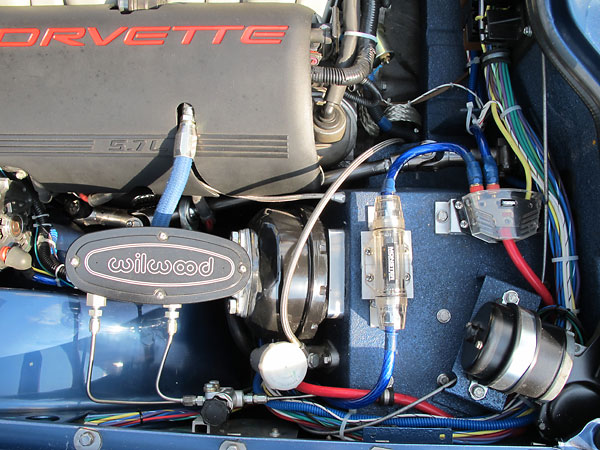
Stinger distribution block and main fuse.
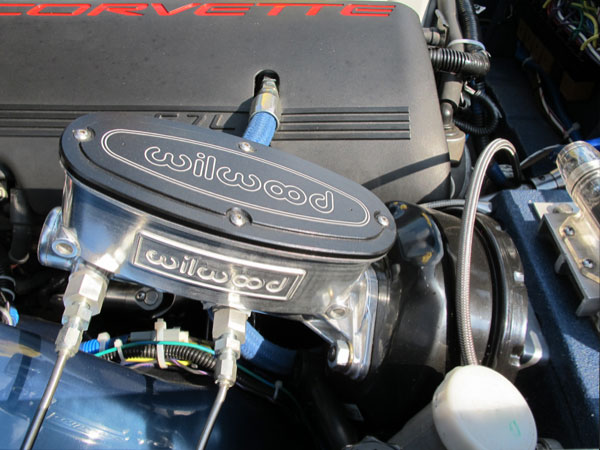
Wilwood 1.125" bore tandem brake master cylinder.
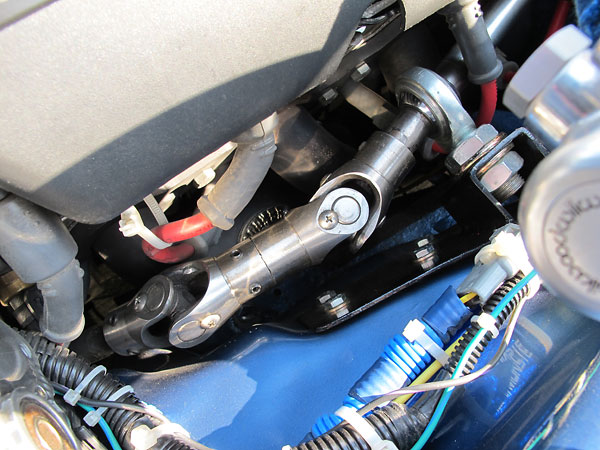
Woodward Precision Power Steering universal joints.
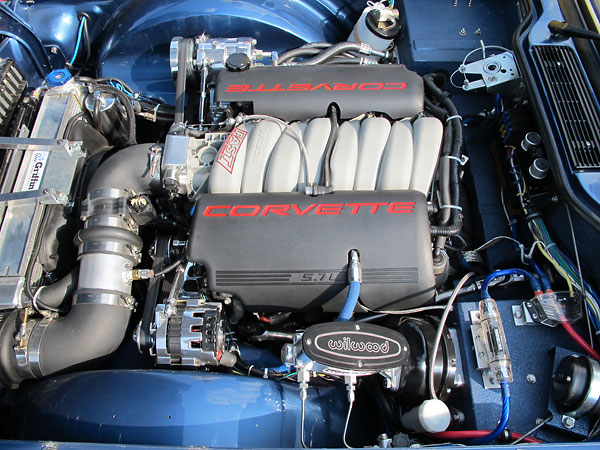
FAST 90mm intake, hand ported by Tony Mamo from AFR.
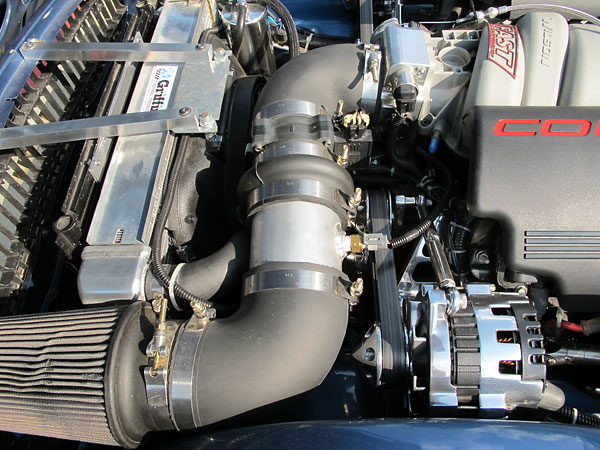
K&N gauze air filter, intake air temperature sensor, and mass airflow sensor.
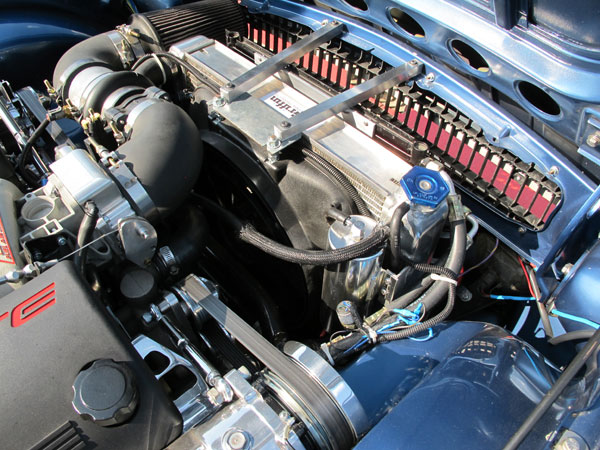
Custom aluminum brackets secure the radiator and AC condenser.
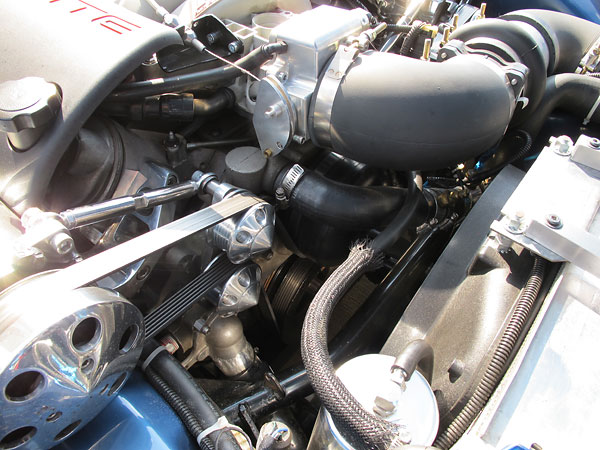
Street & Performance Front Runner accessory bracket / pulley / serpentine belt drive system.
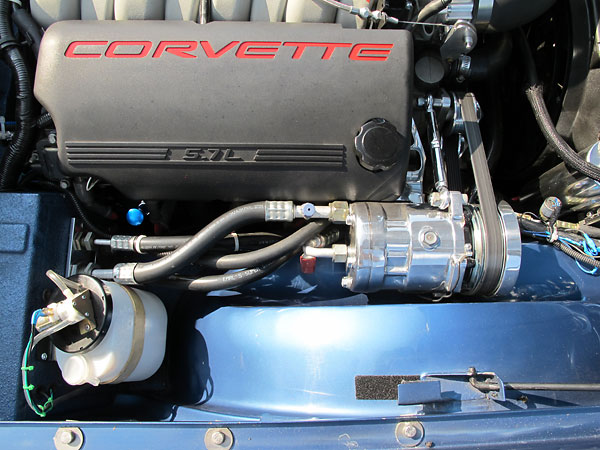
Sanden 508 air conditioning compressor.
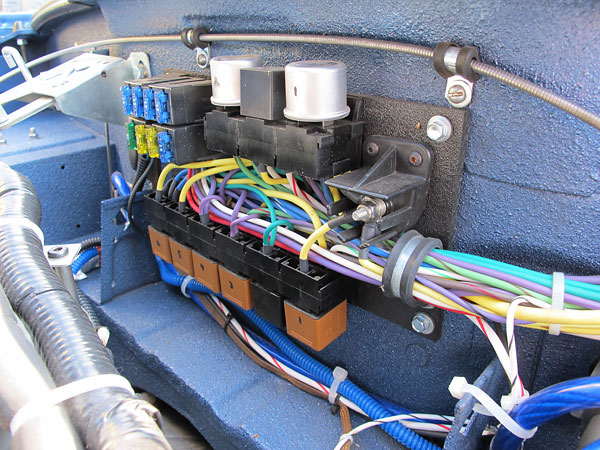
Advance Auto-Wire fuse and relay block.
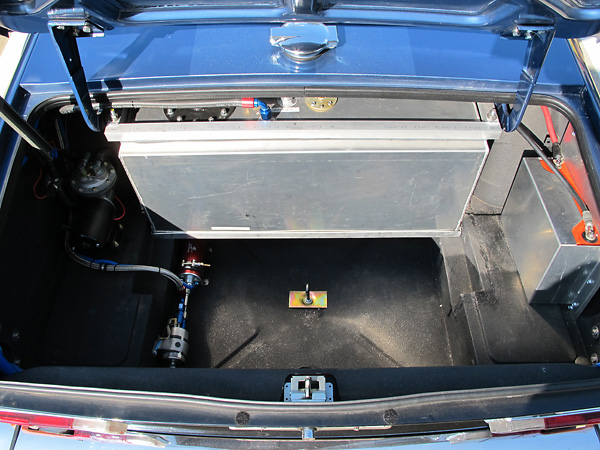
19 gallon fabricated aluminum fuel tank.
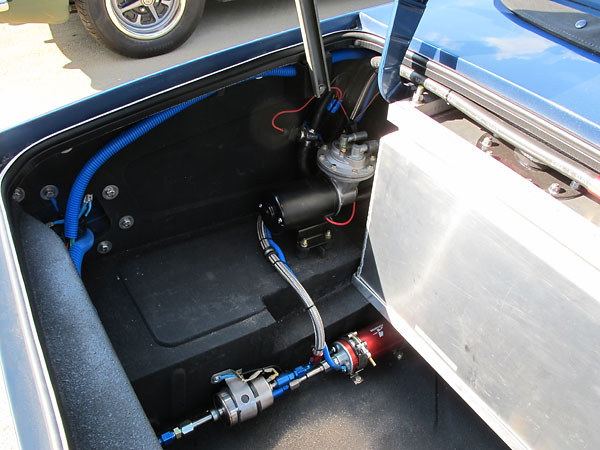
Left: Corvette fuel filter and regulator (1999-2004). Right: Aeromotive inline fuel pump.
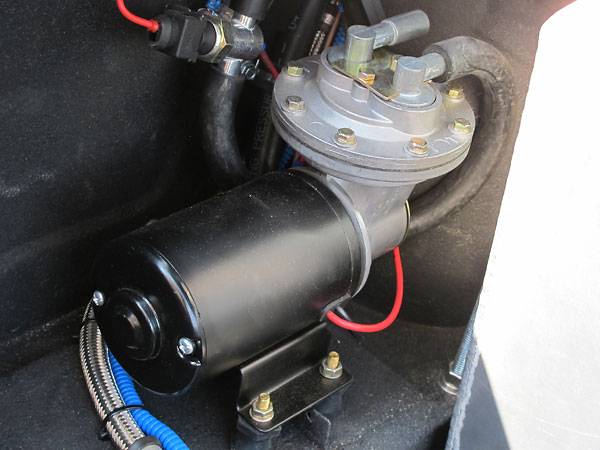
This vacuum pump is connected to the power brake booster. It provides 20psi of vacuum regardless
of engine load and speed. With its own inline pressure switch, it only runs when needed.
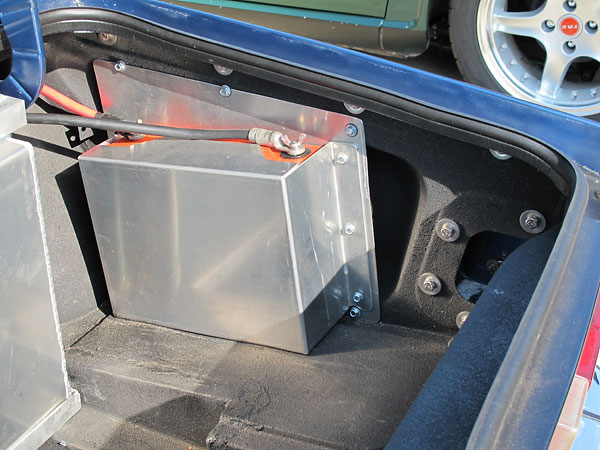
Odyssey Extreme Racing (ER40, nine pound) battery, mounted in trunk.
How It Was Done
Engine Build
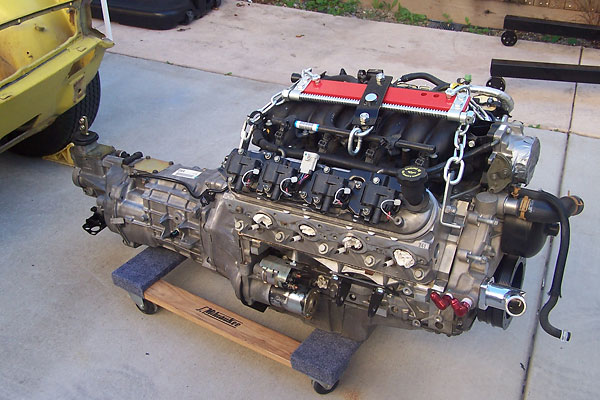
Chevrolet LS1 V8 engine from a 2002 Camaro Z28.
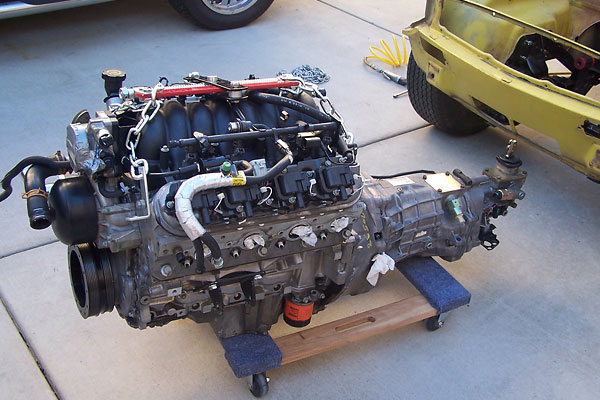
This engine came standard with aluminum block and cylinder heads, electronic fuel injection,
coil-on-plug electronic ignition, and six-bolt main bearing caps.
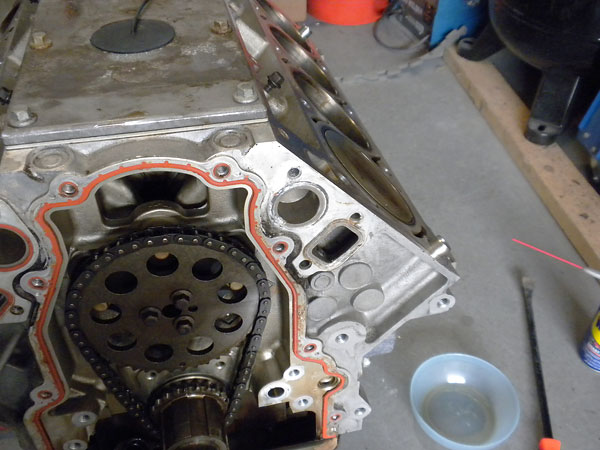
Modern gaskets that don't leak are one of the subtle charms of the LS1 engine.
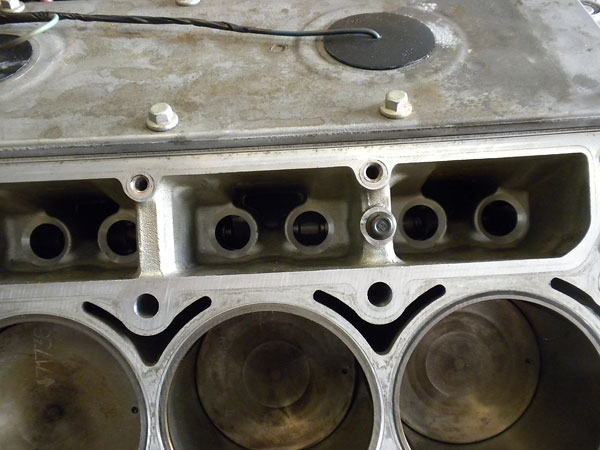
These holes are where roller lifters go, but if you look ahead one photo you'll see the top of
nifty plastic guides (sometimes called "trays") that get inserted here too. The guides keep
the axis of the rollers parallel to the camshaft bore. Surprisingly, they grip the lifters
just firmly enough to facilitate heads-on camshaft swaps.
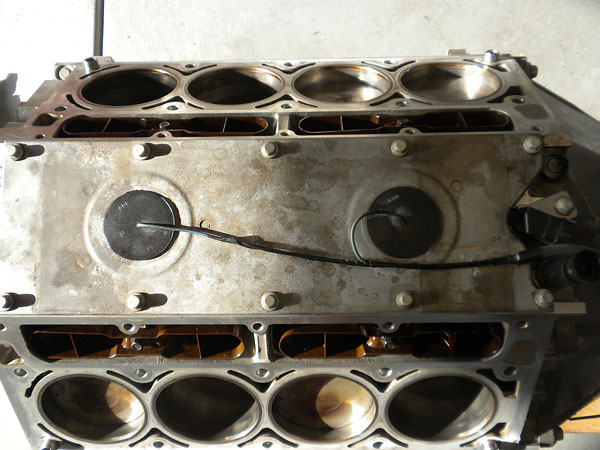
Twin knock sensors mounted on the LS1 valley cover.
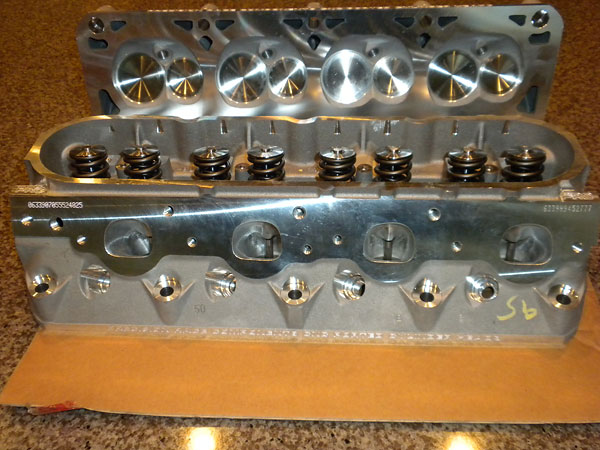
Texas Speed & Performance (TSP) / Precision Race Components (PRC) LS6-style cylinder heads.
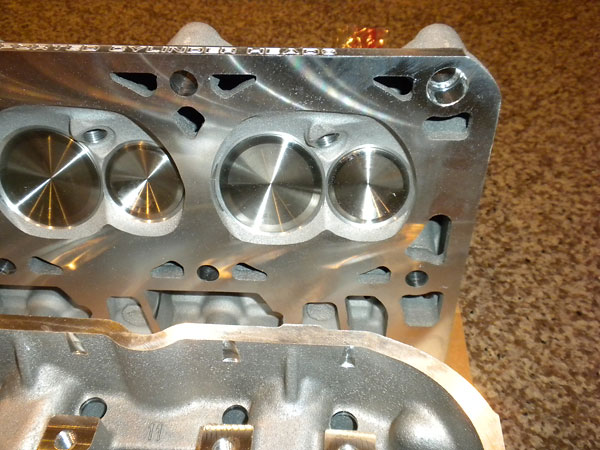
Oversized valves: 2.02" intake and 1.575" exhaust.
62cc combustion chambers for a 10.8:1 static compression ratio.
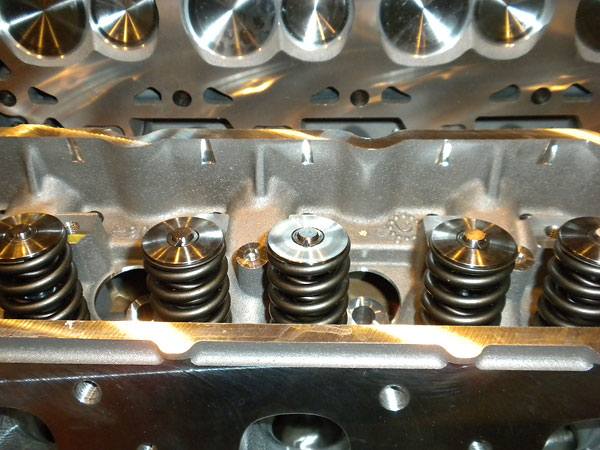
Dual 0.650" lift valve springs.
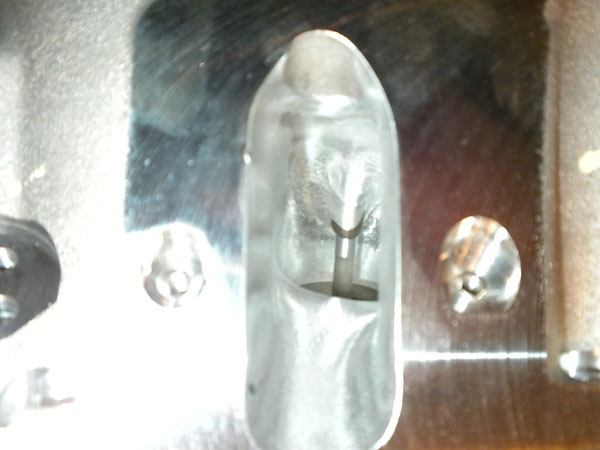
The cylinder head porting was done automatically with a CNC milling machine.
They call this shape "cathedral ported".
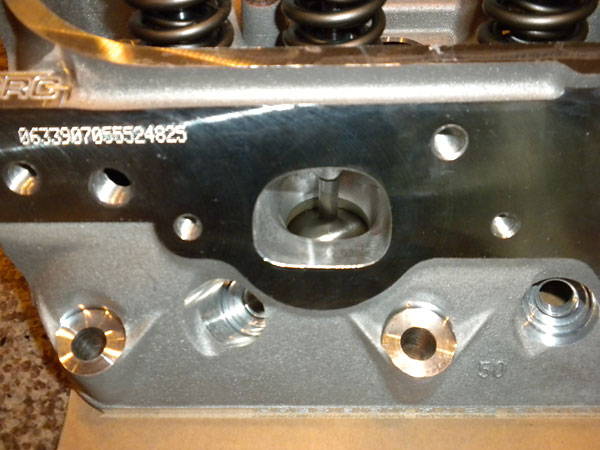
Some LS heads have round exhaust ports. The versions with D-shaped exhaust ports flow better.
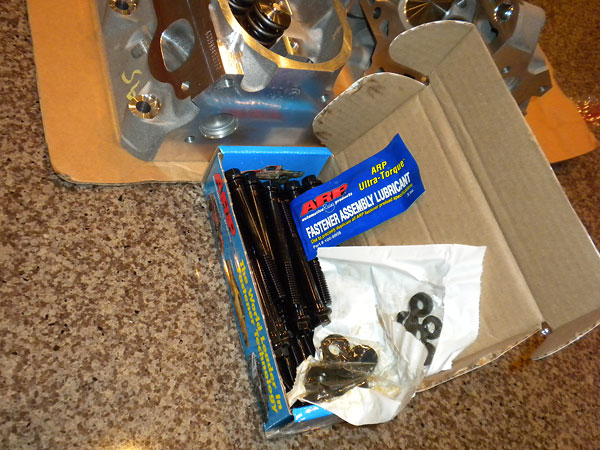
ARP cylinder head bolts. (These are re-usable whereas the OEM bolts were for one-time-use.)
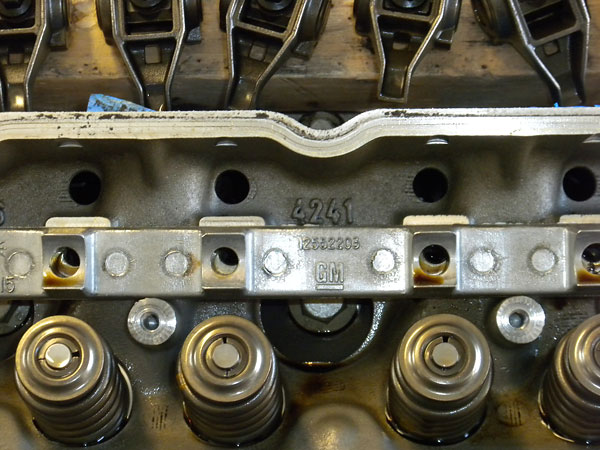
Rockers (top of photo, ready to be installed) mount on individual rocker stands (middle of photo).
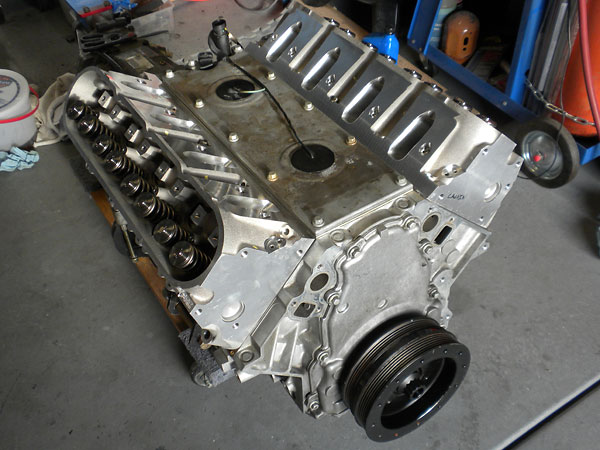
Timing cover and crankshaft pulley installed.
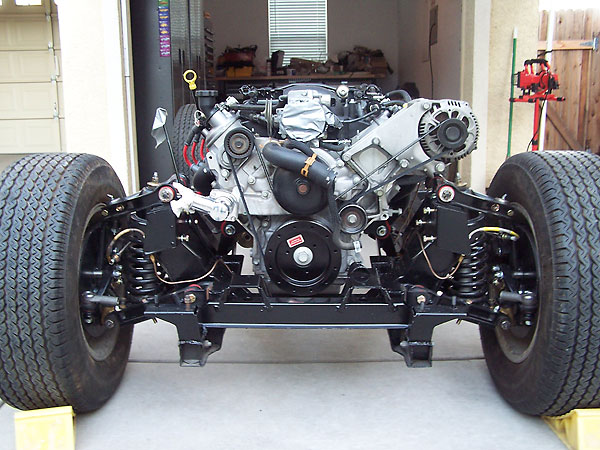
This is just one of many trial installations of the LS1 engine into Calvin's TR6 chassis.
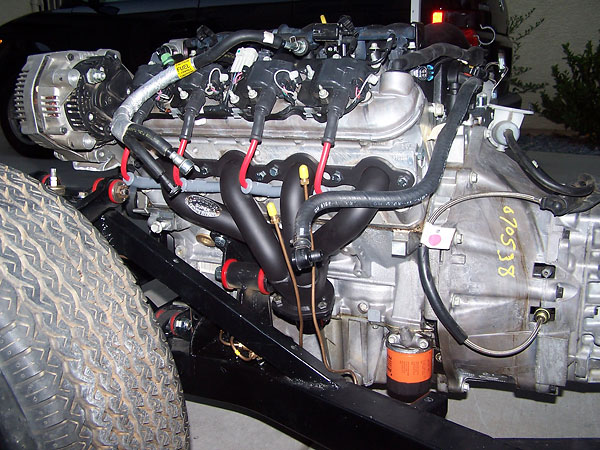
Driver side exhaust header installation. (No problem here.)
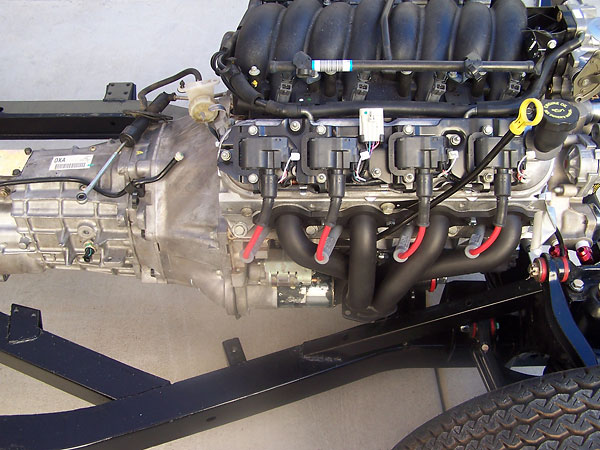
Passenger side header installation. (A little too tight for comfort. Changes shown below.)
Cooling System
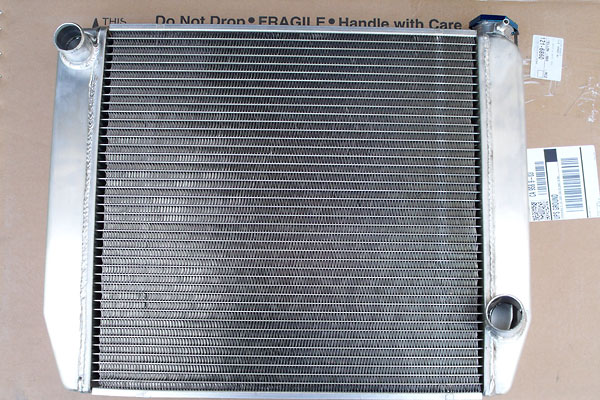
Griffin aluminum crossflow radiator (24" x 19" x 3") with 2-row (1.25" tube) core.
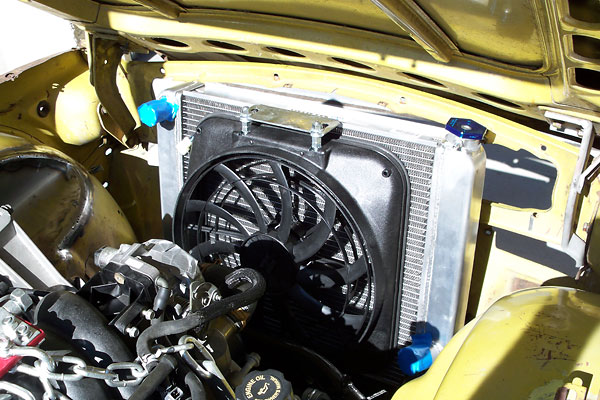
Sixteen inch 2250cfm electric fan with matching shroud.
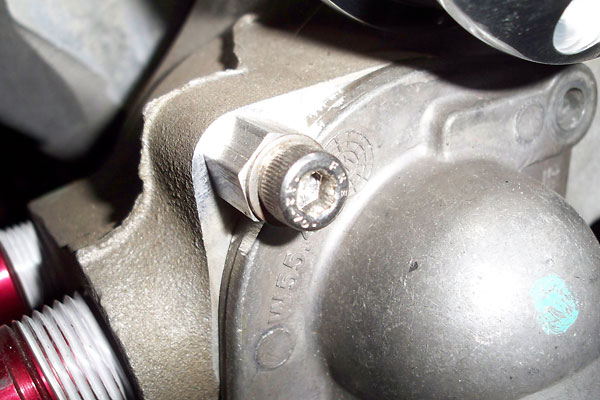
Stock thermostat housing rotated counter-clockwise ninety degrees to point downward.
The standard coolant thermostat for LS-series engines opens at 195°F.
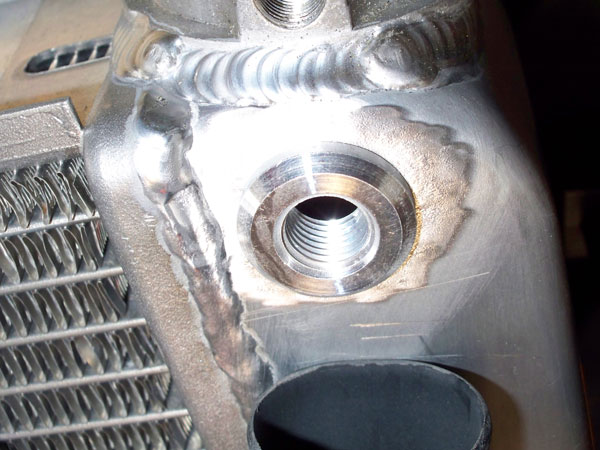
1/4" NPT threaded aluminum bung installed on the radiator to vent out trapped air.
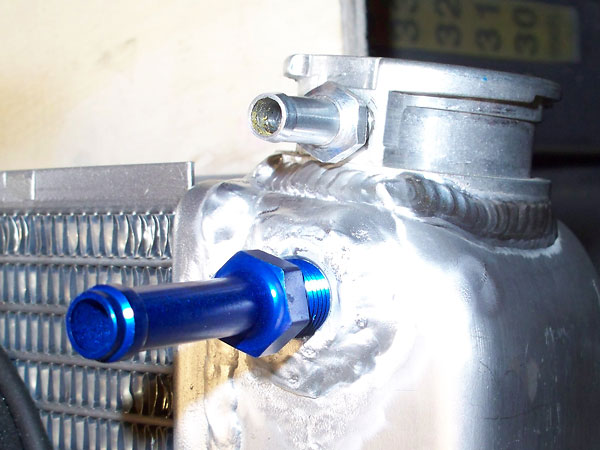
On an LS1, the radiator's steam vent can be plumbed to the warmer system on the throttle body. (Plumbing
to a header tank would be another good option.) Also shown: the hose barb at the pressure relief cap.
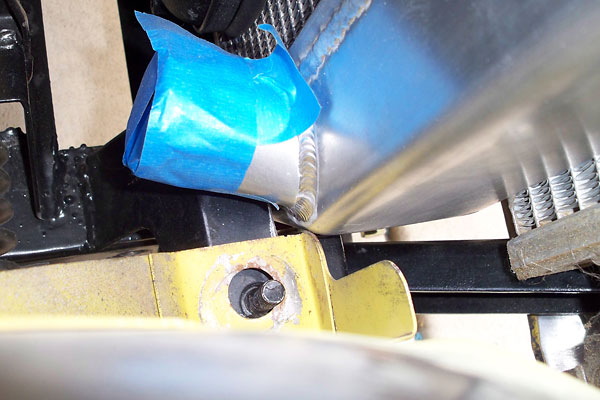
Replaced lower radiator port.
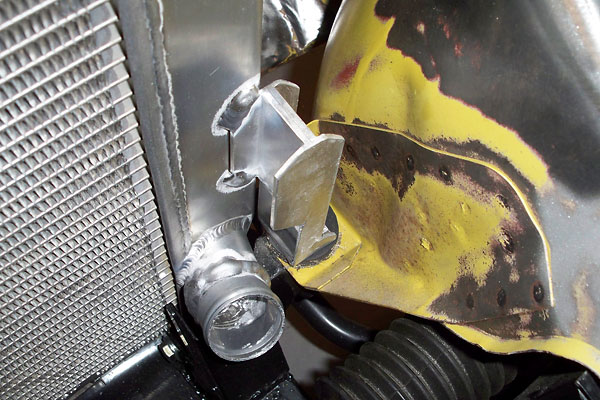
Radiator mounting bracket.
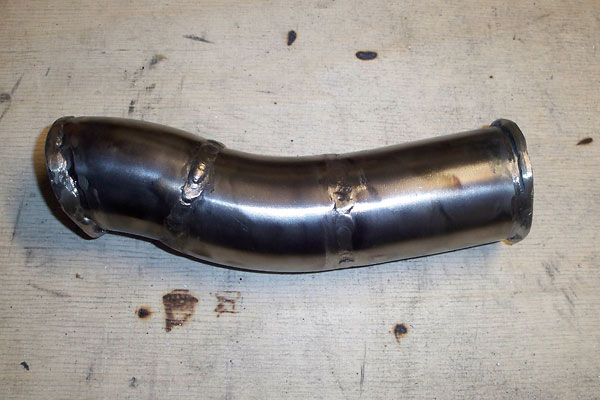
Custom stainless steel tube for the lower coolant line.
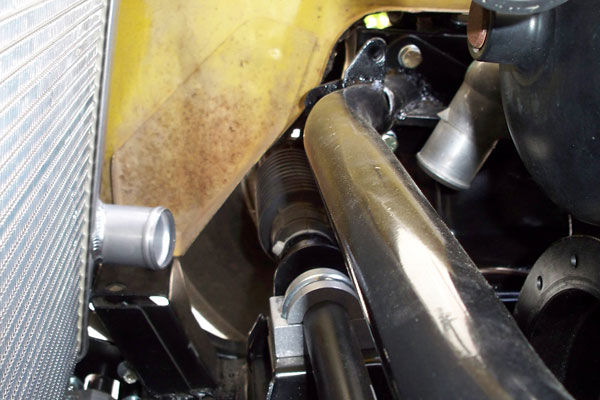
Lower coolant plumbing will go here.
Exhaust System
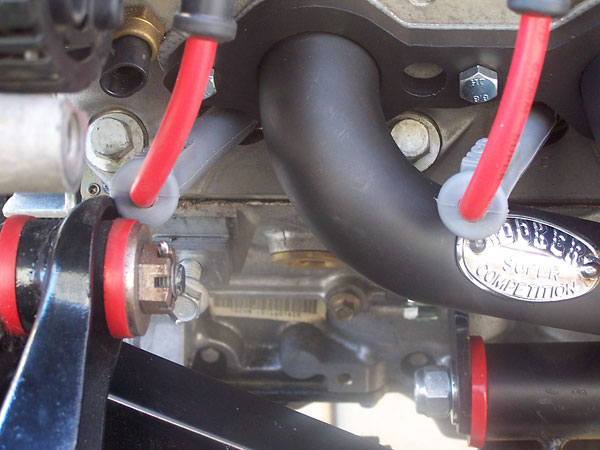
Hooker Super Competition four-into-one exhaust headers.
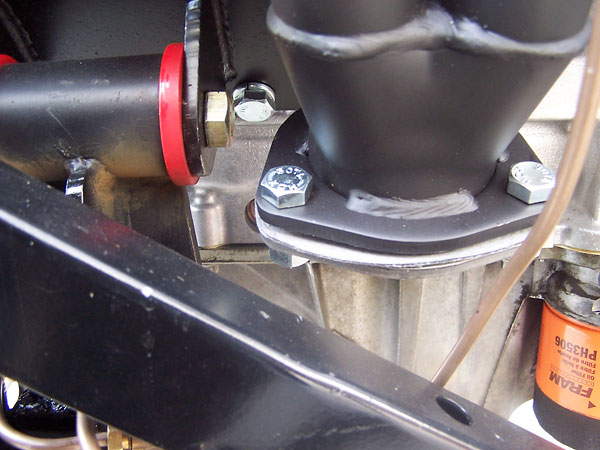
The driver-side exhaust header fit pretty well right out of the box.
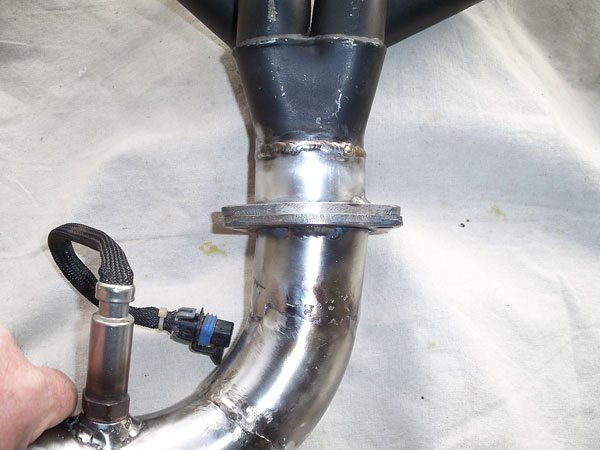
On the passenger-side, the exhaust header was nearly touching the motor mount and also
uncomfortably close to the starter motor, so Calvin decided to extend the header's
lower flange downward by about two inches. At left: oxygen sensor.
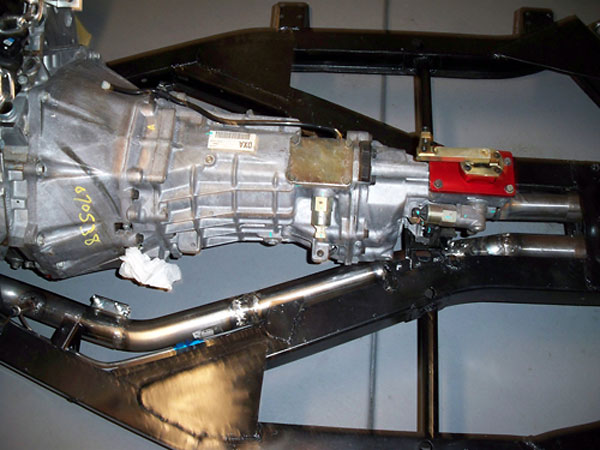
Routing exhaust below the frame would seriously compromise ground clearance, so Calvin was
compelled to engineer a through-the-frame system. For convenient service, from here back
just six stainless steel band clamps hold the exhaust system together
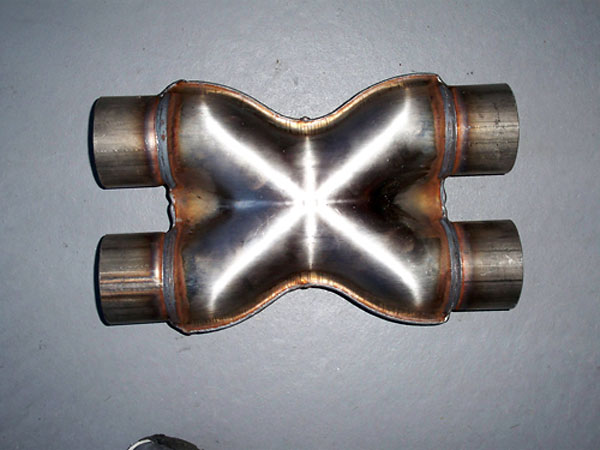
Magnaflow X-pipe.
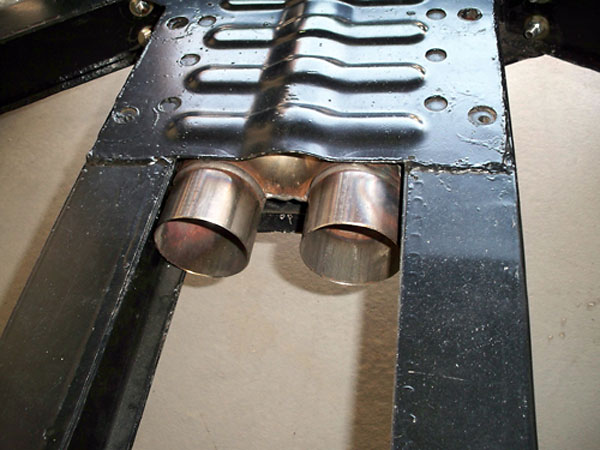
The X-pipe is tucked into the narrow "t-shirt" section of the Triumph TR6 frame. This is
as physically close as Calvin could get the X-pipe to the headers.
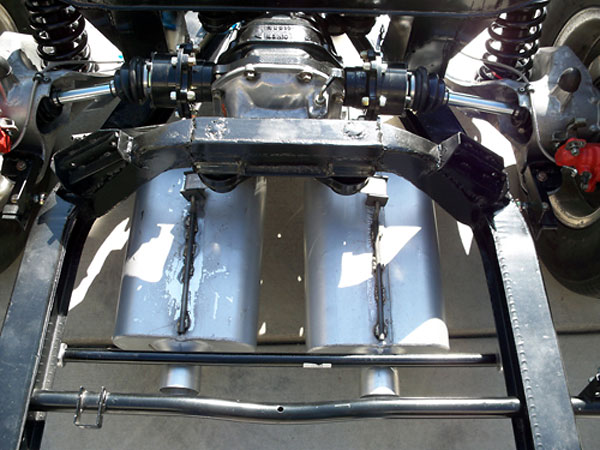
The mufflers shown on this page are FlowMaster 40s, but Calvin took those off pretty soon after
the car was roadworthy because they were too loud. He replaced the FlowMasters with Borla Pro XS
stainless steel mufflers (mounted similarly.) The Borla mufflers are slightly longer and heavier.
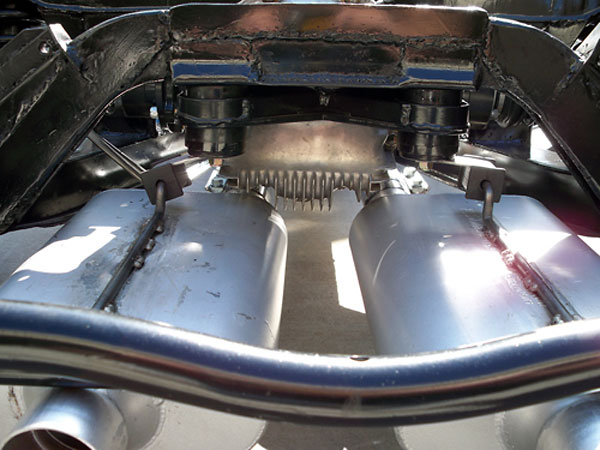
Mounted on rubber hangers, the mufflers don't transfer vibration directly into the body.
Transmission, Clutch, Shifter, Etc.
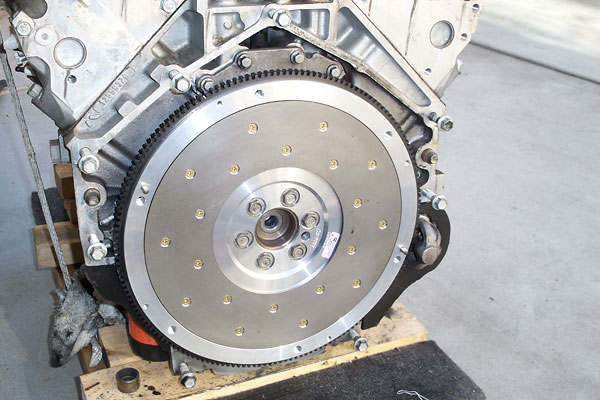
Fidanza 12.5 pound aluminum flywheel with changable clutch surface.
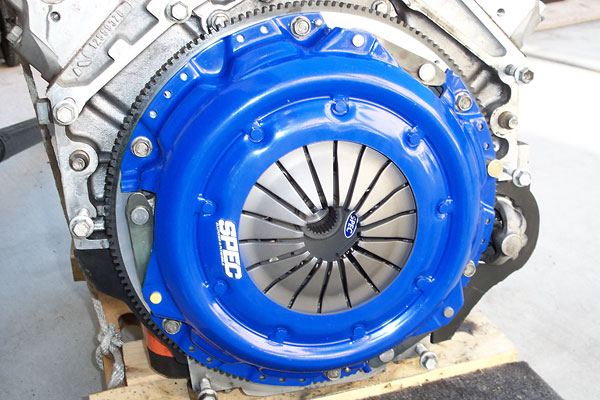
SPEC Stage 2+ pressure plate.
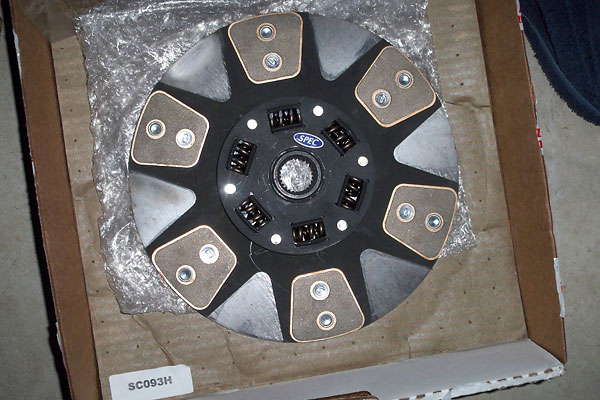
SPEC clutch disc. This clutch/pressure plate combination should be good for ~625 foot pounds of torque.
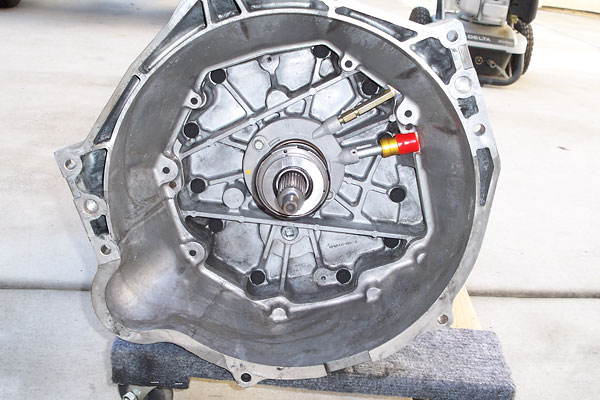
LS1/T56 bellhousing, including annular clutch slave cylinder.
(Also known as a "hydraulic throw-out bearing".)
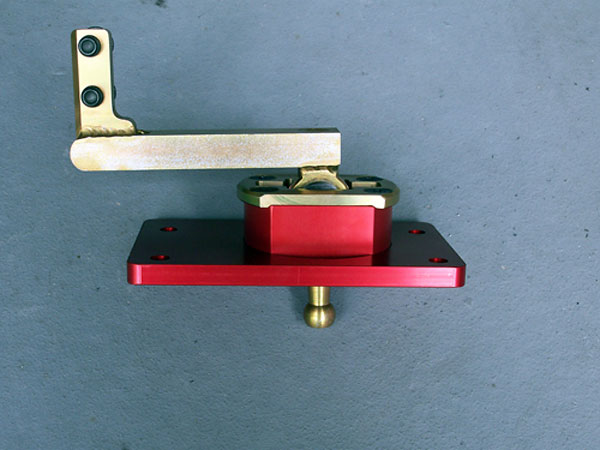
Street & Performance Inc. gear shifter.
(That company markets this shifter as a "shifter handle relocator.)
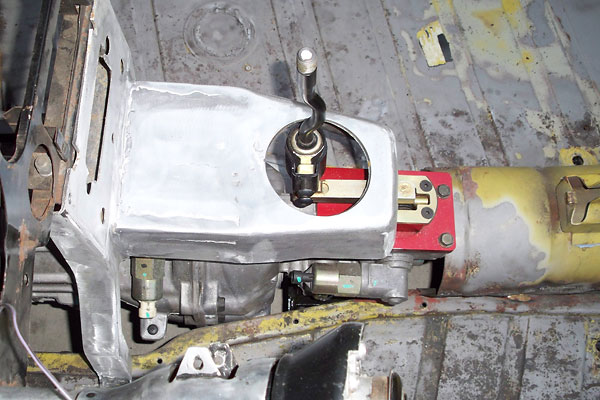
Original Triumph TR6 dash support, stripped down to bare aluminum and then cut
and extended 4.5" rearward. The special gear shifter extends forward to meet it.
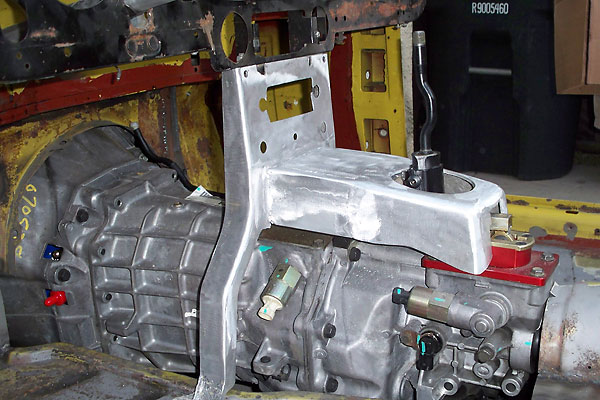
Tremec T56 6-speed with normal GM F-body gearing. Not lightweight and not compact...
but it has its virtues, including two overdrive gears. (Great for fuel economy!)
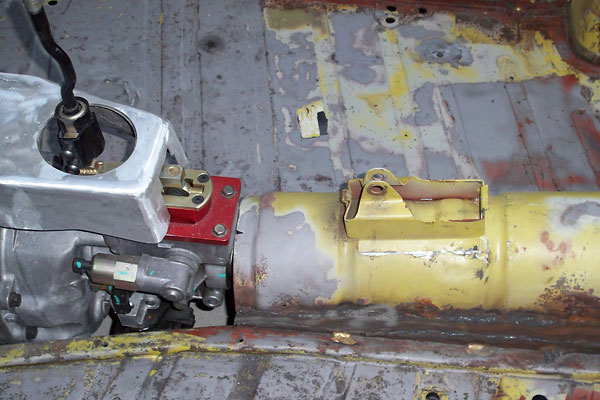
The original driveshaft tunnel has been cut out and reinstalled about two inches higher.
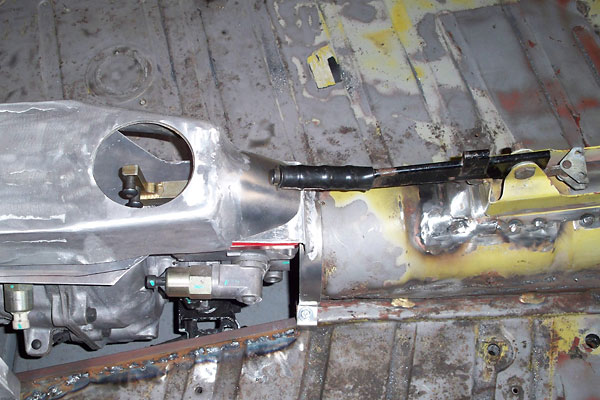
The parking brake lever had to be shifter rearward (3.5").
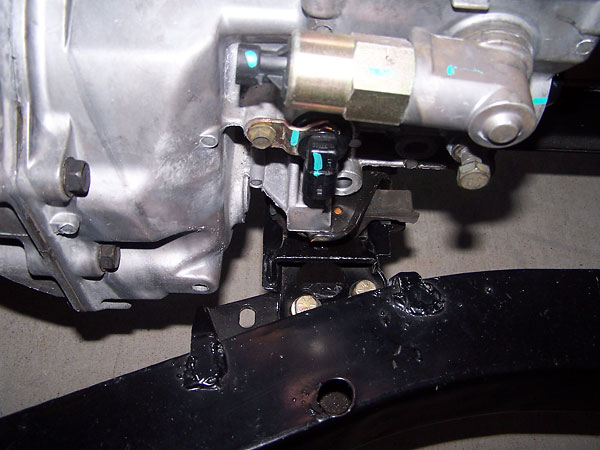
The T56's bulky reverse gear lockout solenoid. Near the end of the build, after the car
had been test driven multiple times, Calvin decided this solenoid stuck out too far.
He removed it and substituted a cap with a heavy spring and plunger. Reverse can be
engaged while moving forward, but it will take a little muscle.
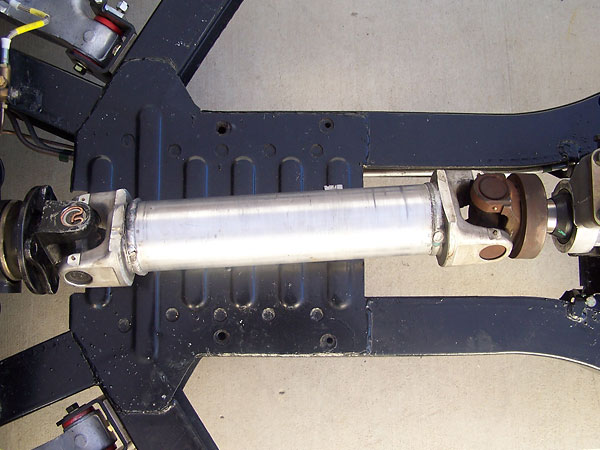
Chevy Camaro 3" aluminum prop shaft, shortened to 25".
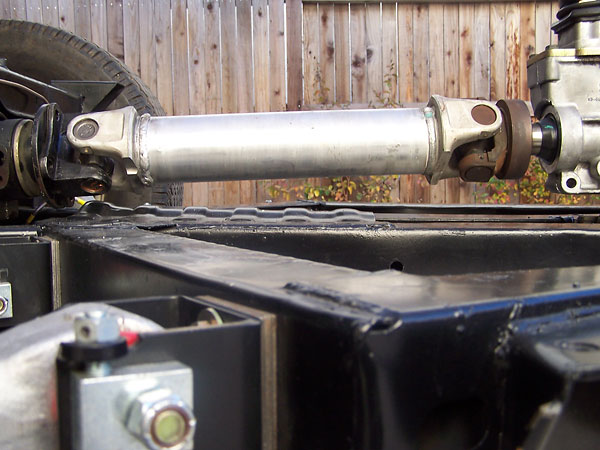
Nissan Infiniti Q45 U-joint at the differential. Camaro-spec U-joint at the transmission.
Fuel System
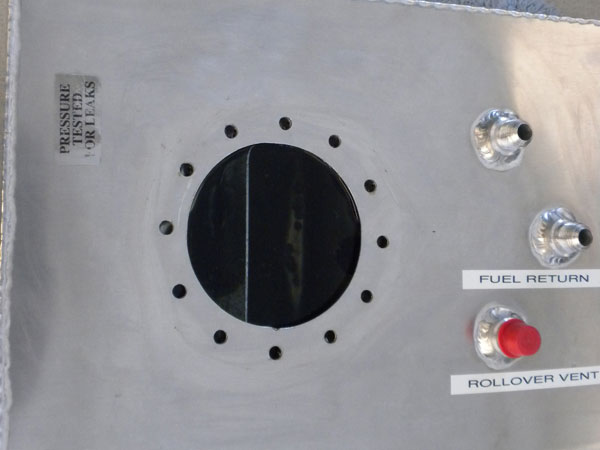
Racers Choice 19 gallon aluminum fuel tank (12" x 12" x 30"). Calvin cut open one side of
the tank, inserted baffles, TIG welded them into place, and welded the exterior back up.
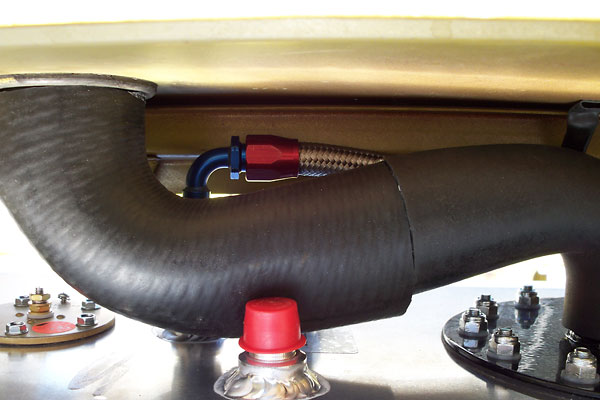
A stock Triumph TR6 fuel filler connects to a 2" inside diameter hose.
The filler neck on the fuel cell accepts a 1.75" ID hose.
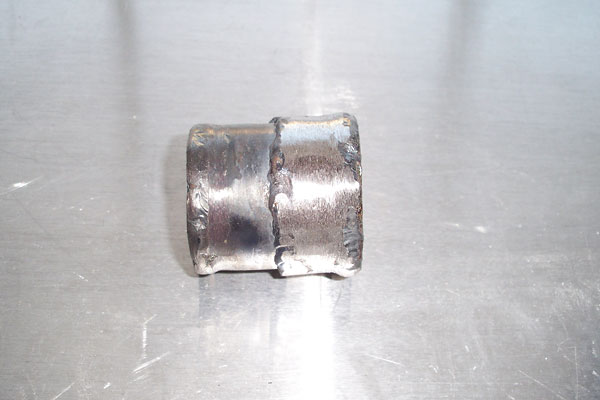
Calvin fabricated this coupler to mate the two fuel hose elbows together.
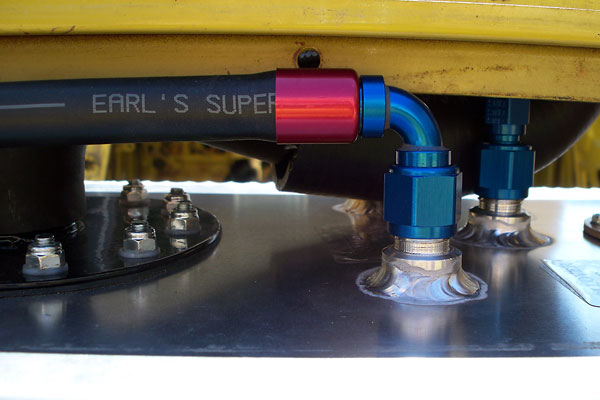
Foreground: the hose for the rollover vent, connected with a "dash eight" (half inch)
AN fitting. The fuel cell came with similarly large fittings for its other two ports.
Calvin used dash eight to dash six converter couplings into 3/8" braided hoses.
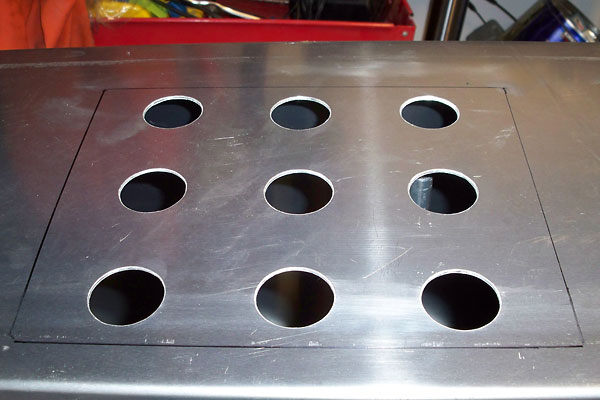
Calvin's original plan was to use racecar-style fuel cell foam to prevent sloshing of fuel within his
tank. That foam breaks down and has to be replaced every few years, so instead he decided to
add a simple sump to the bottom of his tank and draw fuel from there. 9 holes, 1.125" diameter.
(In the righthand center hole, you can see the original but now-obsolete fuel pickup tube.)
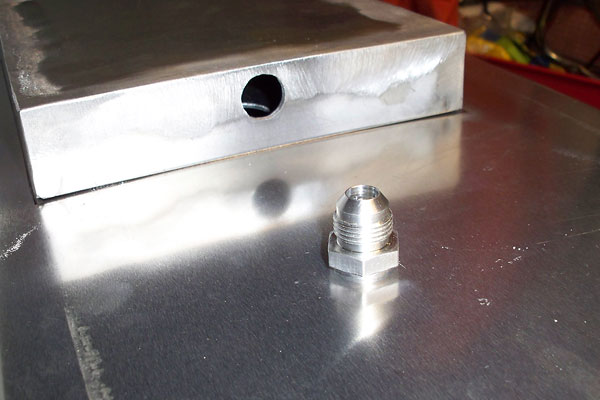
The sump measures 8" by 10" by 2" deep. At right: 8AN aluminum bung.
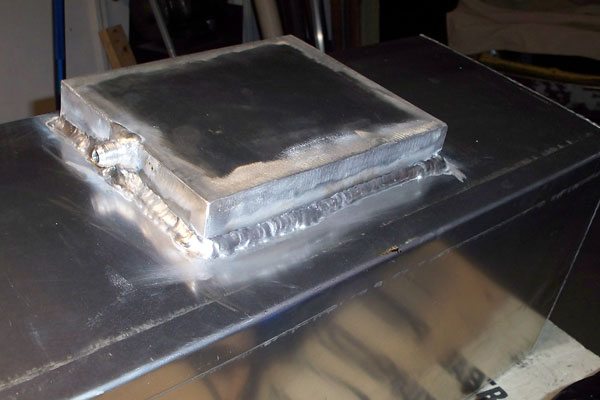
With the sump TIG welded into place, the bung points to the driver's side.
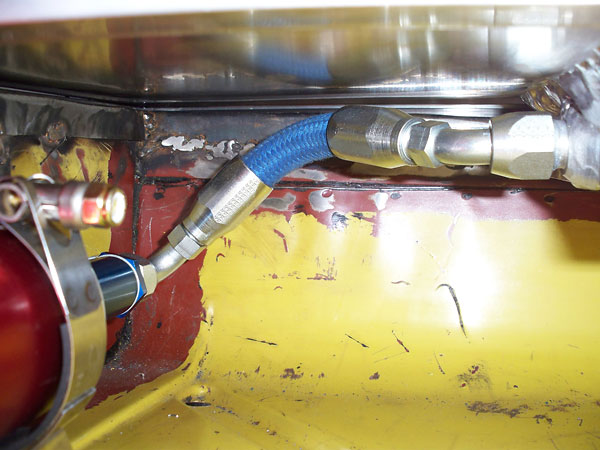
Aircraft style connection of the Aeromotive high pressure fuel pump to the fuel tank. From
the pump, gas goes directly into a filter assembly with a built-in pressure regulator.
A portion of the fuel continues to the engine. Excess is routed back to the tank.
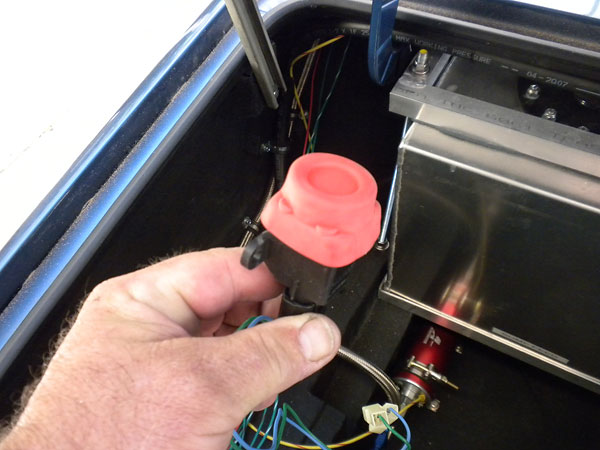
In the event of an accident, this inertia switch would shut-off the high volume fuel pump.
Front Suspension and Brakes
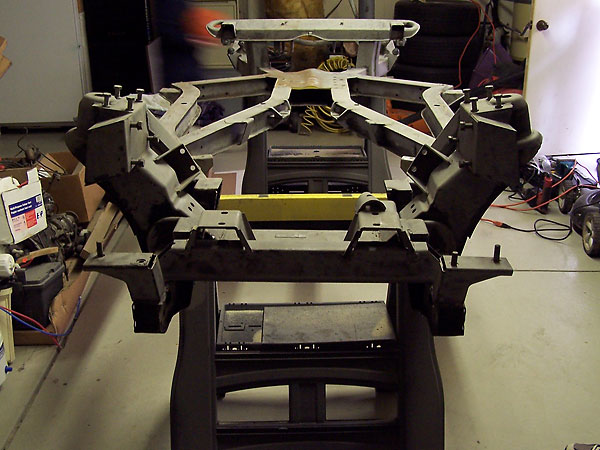
This is basically a "before photo." Many alterations to the TR6 frame will be shown below.
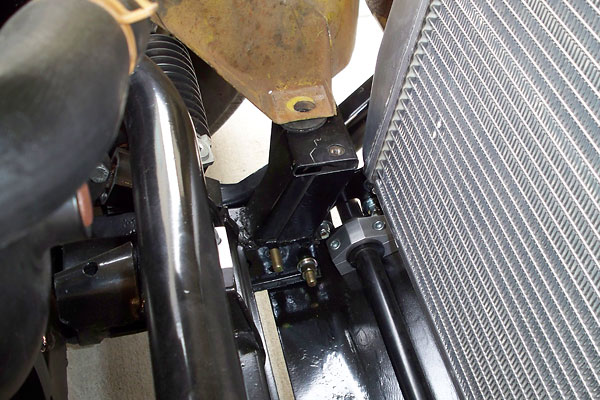
Original Triumph TR6 front anti-sway bars are mounted quite low, and vulnerable to contact with curbs.
Calvin followed Ken Hiebert's lead and re-mounted this Good Parts anti-sway bar higher, on the top surface
of the car's skid plate. This is, however, an early photo of that. He subsequently shifted the skid plate and
anti-sway bar forward about 1.25". Doing so improved the anti-sway bar link geometry and also provided
more clearance for radiator installation. (He lowered the radiator slightly for filler cap to hood clearance.)
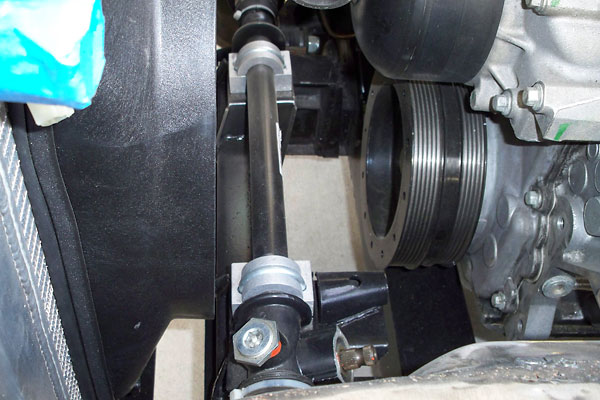
Quick ratio steering rack: 2.5 turns lock-to-lock versus 3.5 turns as standard.
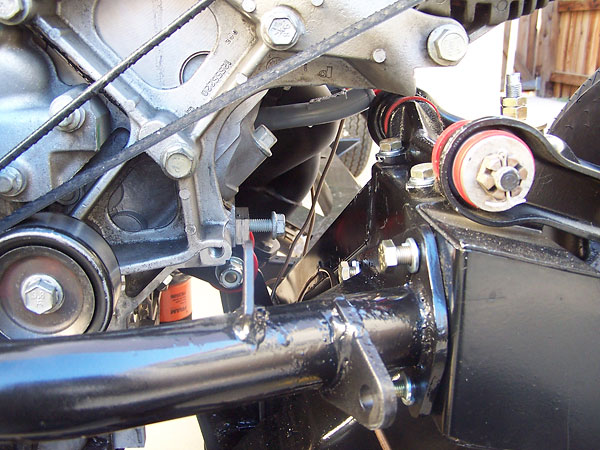
Calvin initially set-up the front suspension with KYB shock absorbers, but he has recently
replaced them with adjustable Spax shock absorbers. He has them set pretty stiff too.
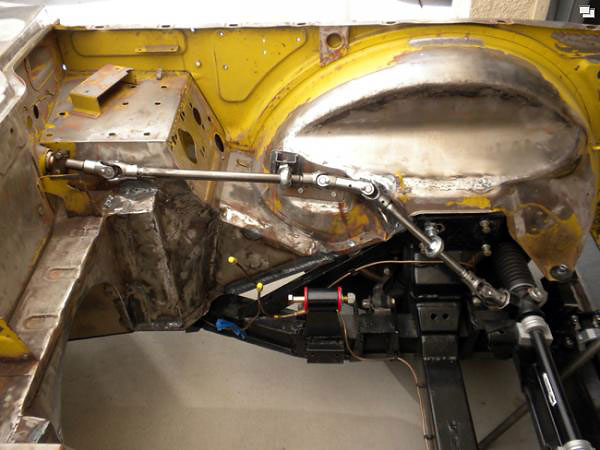
To route the steering around the engine, Calvin used Woodward Power Steering Products components.
He special ordered u-joints to mate to stock Triumph TR6 parts (0.563" by 36 splines at both the
rack and pinion and the steering column.) The opposite ends of those u-joints and the components
in the middle are all 0.750" by 20 splines.
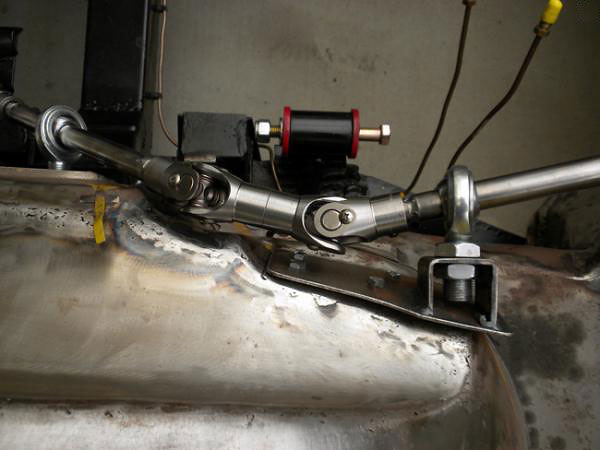
There are two tubular intermediate shafts, both constructed of 0.75" OD by 0.490" ID material.
Woodward sells splined tips that get welded into these. To install them, Calvin drilled out the
tubes to 0.514" (1.25" deep) on all 4 ends. The OD of the splined tips were 0.512". Plug them
in and they're self aligning; fire up the TIG welder and make the assembly permanent.
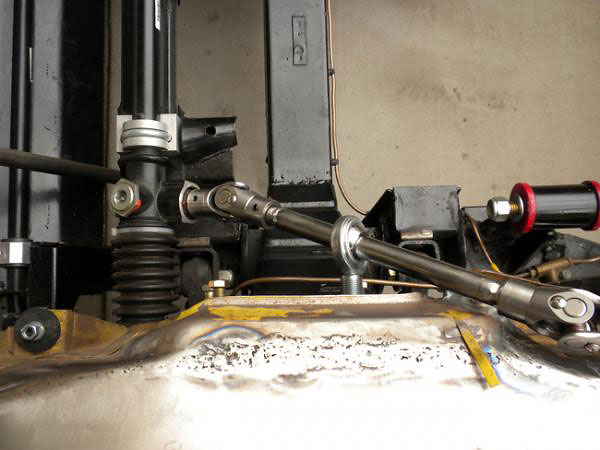
There are two Heim joint supports: one on the inner fender and one on the suspension tower box.
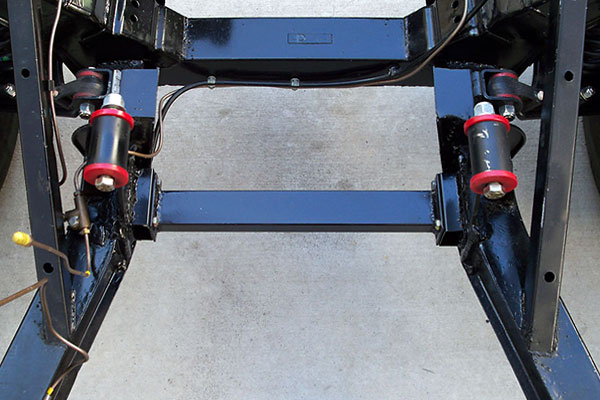
Bolt-in crossmember, added to reinforce the motor mounts.
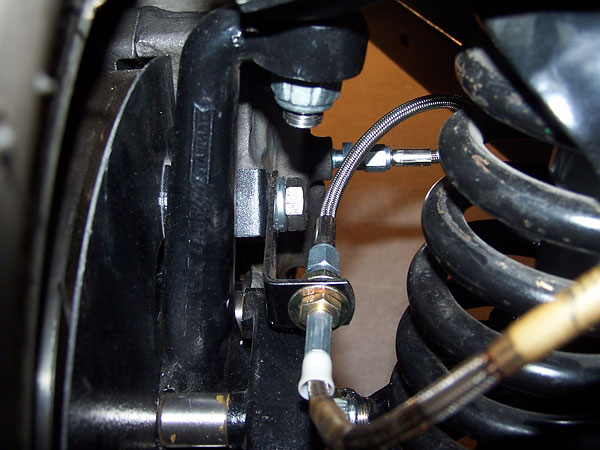
Stock TR6 rotors, cross-drilled and slotted. Braided stainless steel brake lines.
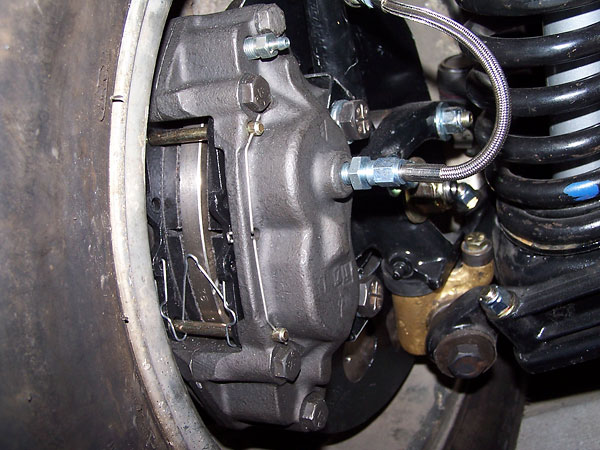
1985 Toyota 4x4 brake calipers. Incidentally, the original Triumph dust shields were
still installed here, although trimmed slightly to suit the larger calipers. Since these
photos were taken, Calvin has upgraded to Wilwood 4-pot calipers and 12.19" rotors.
Enjoying this article? Our magazine is funded through the generous support of readers like you!
To contribute to our operating budget, please click here and follow the instructions.
(Suggested contribution is twenty bucks per year. Feel free to give more!)
Rear Suspension and Brakes, Etc.
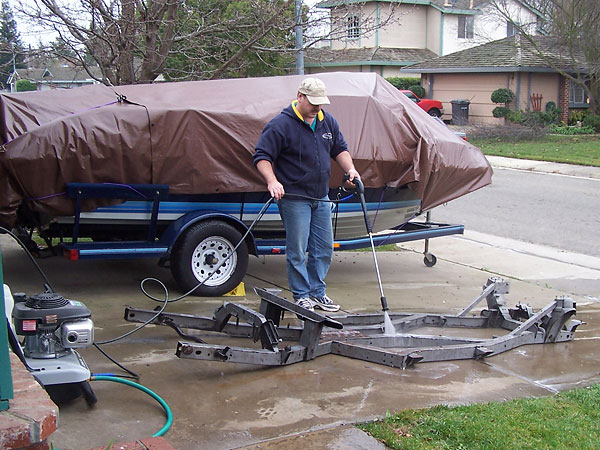
Another before photo: this one shows rear frame design details better.
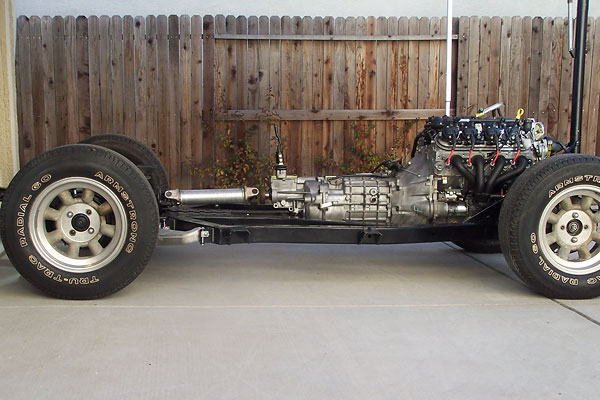
The original Triumph TR6 rear axle ratio was 3.69:1.
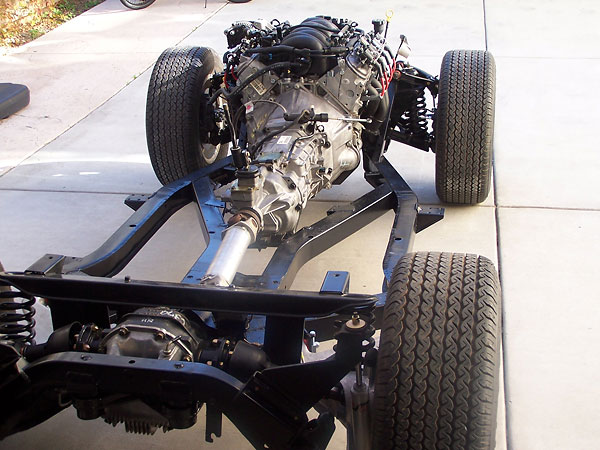
Nissan R200 rear end out of a Nissan / Infiniti Q45. The 3.54:1 ratio R200 rear ends came
with six bolt housings, whereas other versions came with five-bolt housings. Richard Good
offers mounting brackets for putting either version in a Triumph.
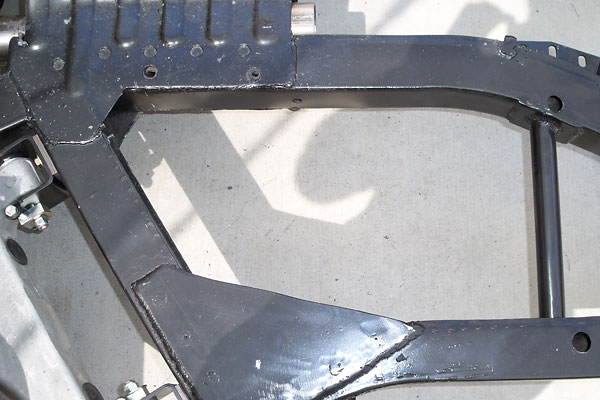
At the right you can see bracing for the transmission mounts, fabricated from thick
wall round tubing (1.5" OD by 0.25" wall), and 3" square mounting plates.
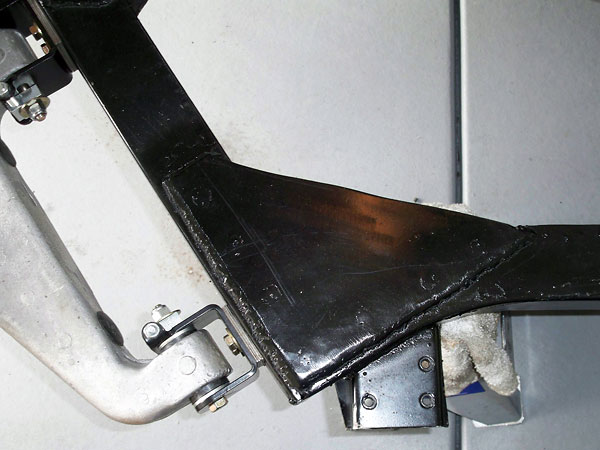
This photo shows reinforcing plates added to the top surface of the frame (only).
They're attached with plug welds plus welds around the perimeter.
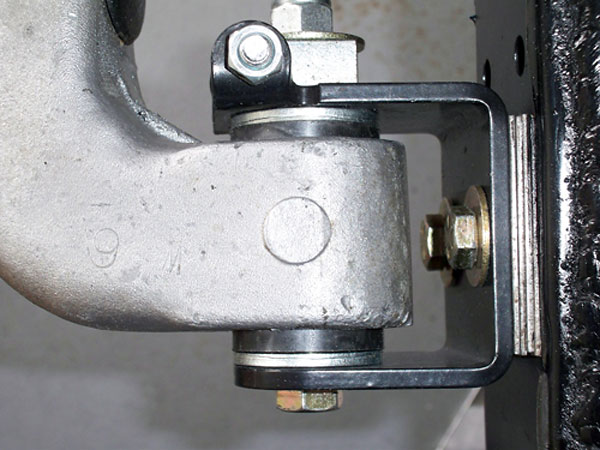
Good Parts adjustable trailing arm attachment brackets and Nylatron bushings.
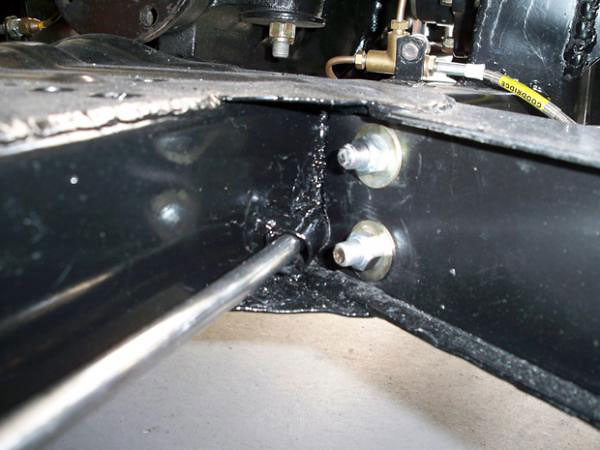
Steel tubes were welded into the frame for routing fuel and brake lines.
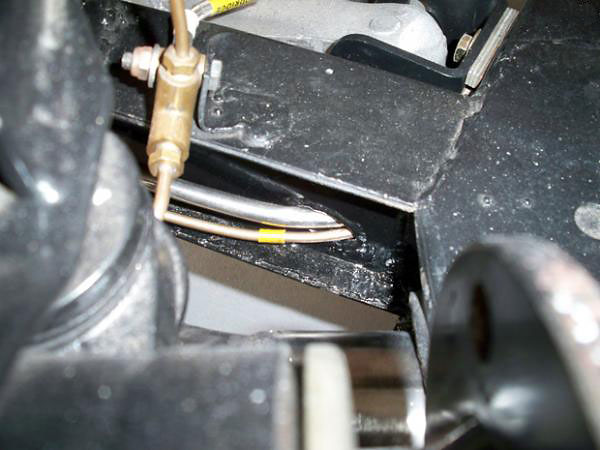
The fuel and brake lines were strategically routed to avoid exhaust heat.
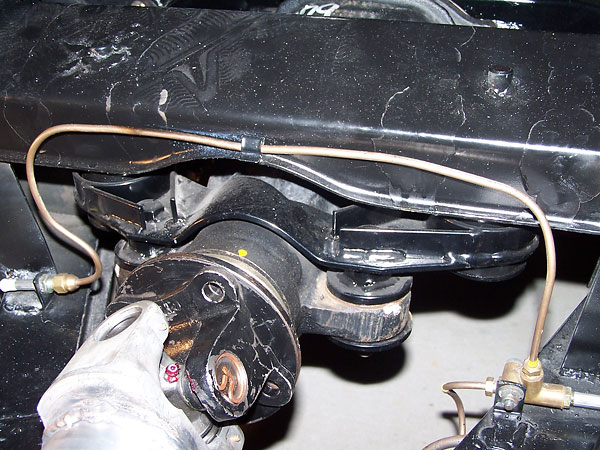
This adapter bracket for mounting an R200 rear end is from Richard Good / Good Parts.
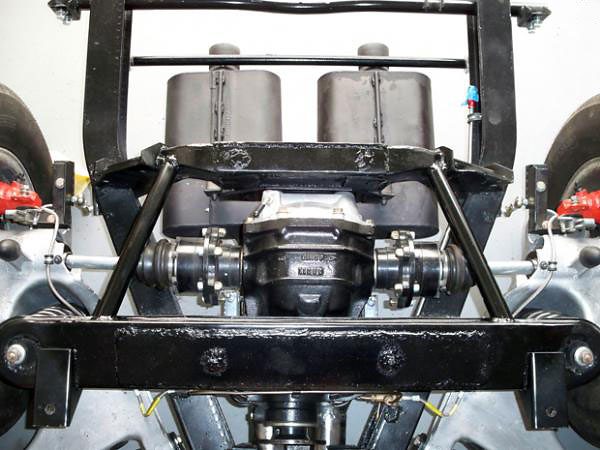
Many reinforcement plates and braces were welded to the TR6 chassis.
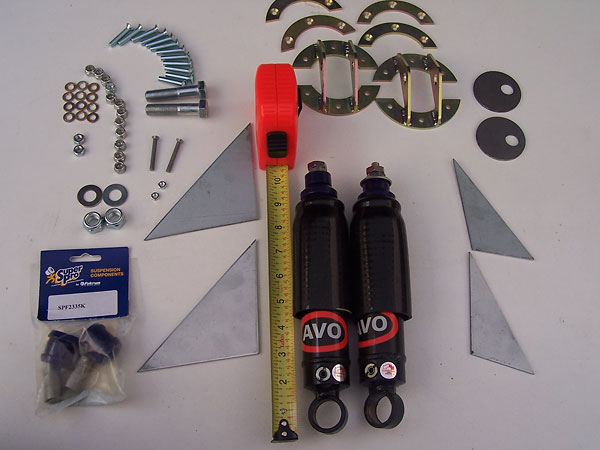
Roadster Factory (Revington TR) coilover conversion kit, featuring AVO shock absorbers.
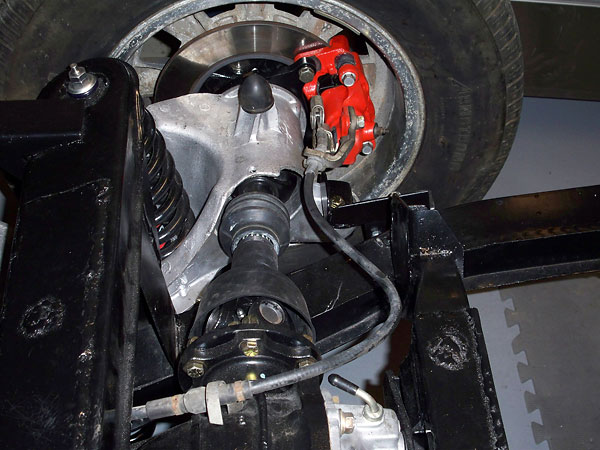
These are single-adjustable shock absorbers, although the adjuster screws are hidden.
Calvin drilled access holes, so he can adjust them from outside with an Allen wrench.
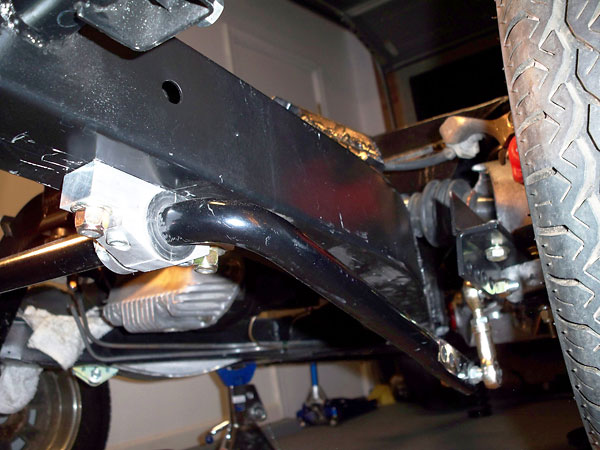
Good Parts rear anti-sway bar. Calvin relocated the sway bar rearward because
Richard Good's original design conflicted with Calvin's coilover conversion kit.
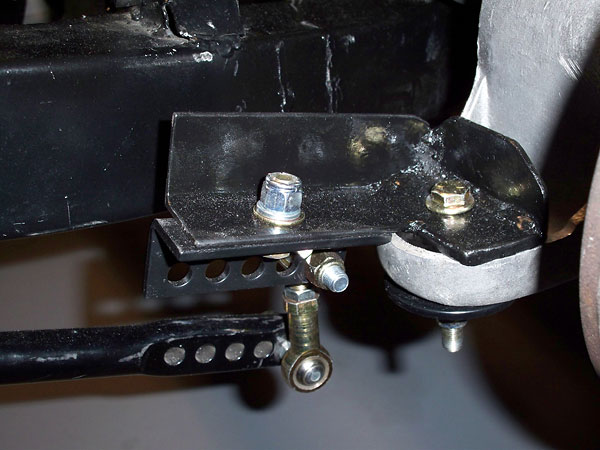
The rear sway bar has five selectable stiffness settings.
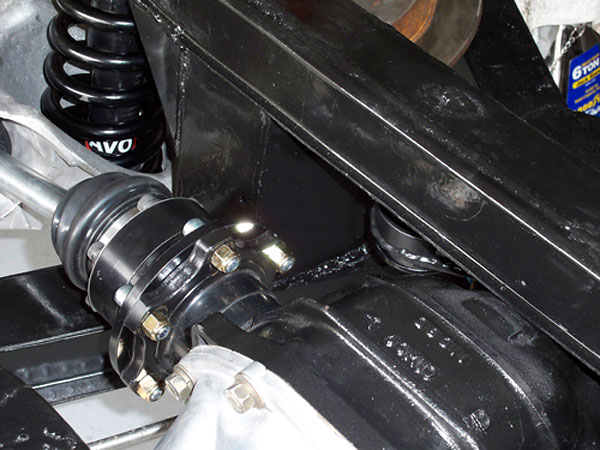
Calvin's experience is that front differential mounts are one of the weaker links of
the Triumph TR6 chassis, so he put particular care into reinforcing them.
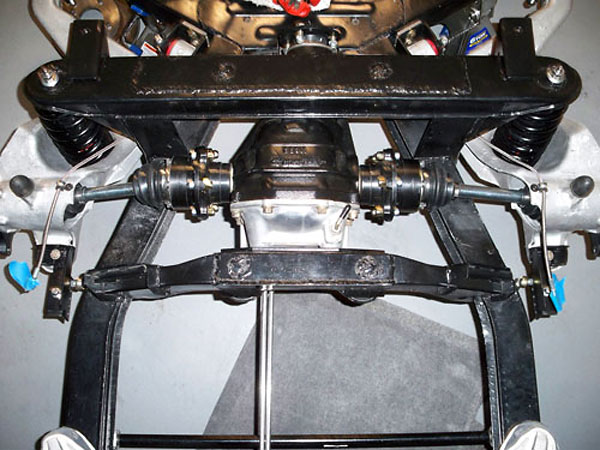
This photo is a nice overview of the rear suspension, but it also shows the 3/8" stainless
steel fuel line during installeation. (AN fittings thoughout. No hoses or barbed fittings.)
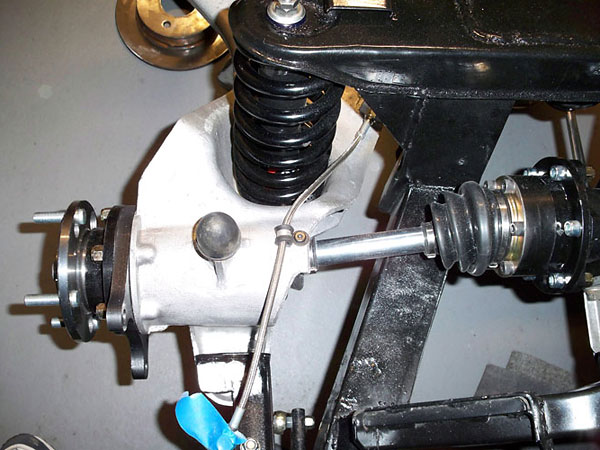
Triangular reinforcements have been welded-in both front-and-rear
on both righthand and lefthand shock absorber towers.
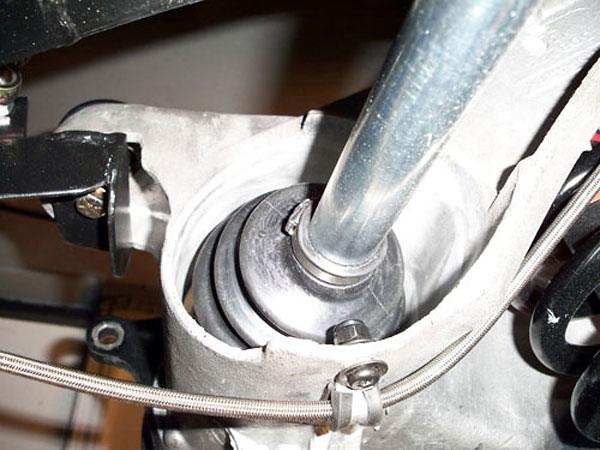
Close tolerance (~0.100") of CV joint boot to housing.
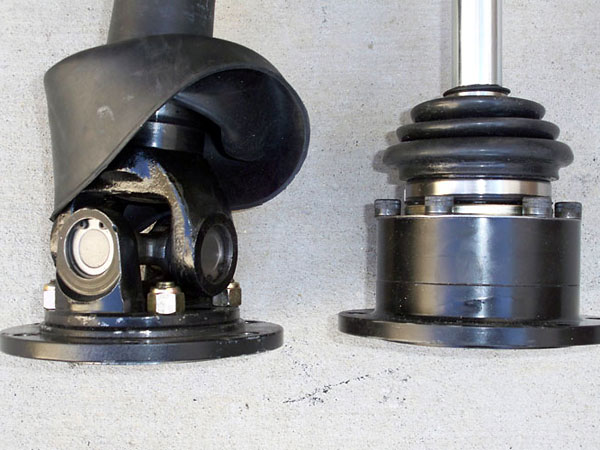
At left: an original Triumph TR6 universal joint halfshaft.
At right: one of Richard Good's first generation constant velocity joint halfshafts.
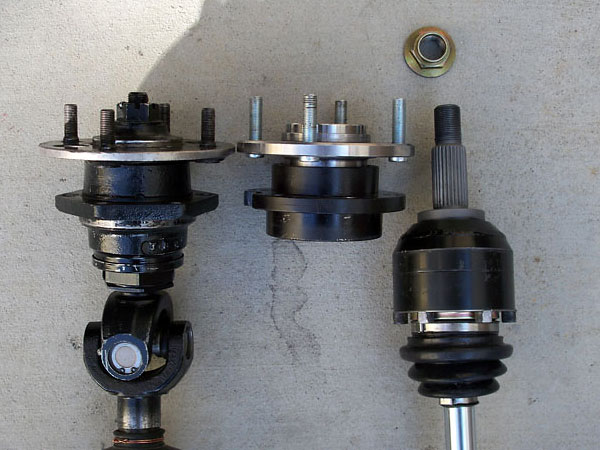
It only took a couple test drives to destroy one of the first CV-jointed halfshafts Calvin tried. "What!
They weren't designed to deliver 400+ horsepower?" Calvin called Richard Good and told him what
happened. Good Parts immediately sent new and improved axles at no charge. The first generation
version had used floating CV joints both inboard and outboard, whereas the second generation
design featured a floating-inboard / stationary-outboard combination.
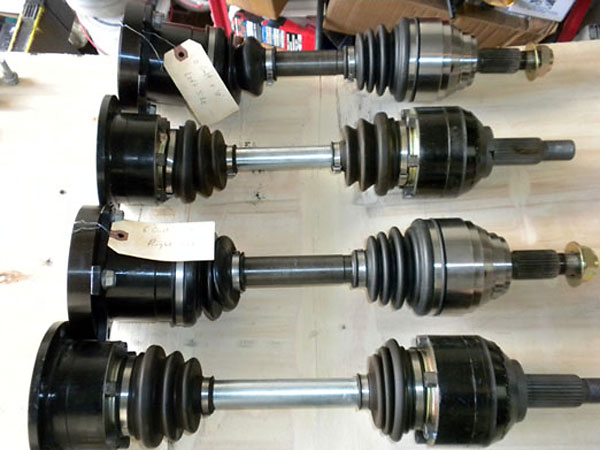
In this view, the second generation axles are marked with tags; the old ones aren't.
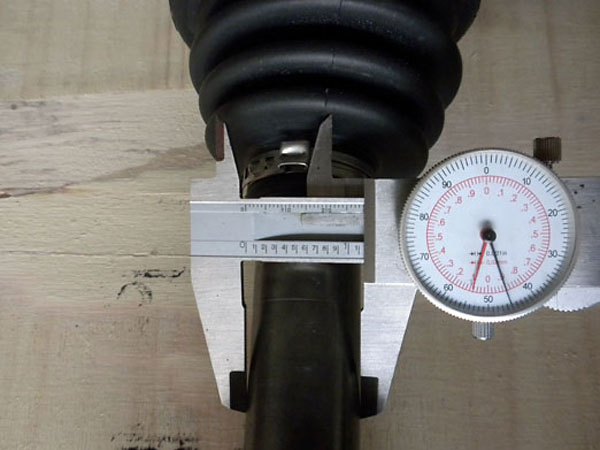
The diameter of the second generation axle shafts is 1.145", and that's about 0.20" larger
than the first generation shafts. The weight difference comes to about 2.6 pounds per side.
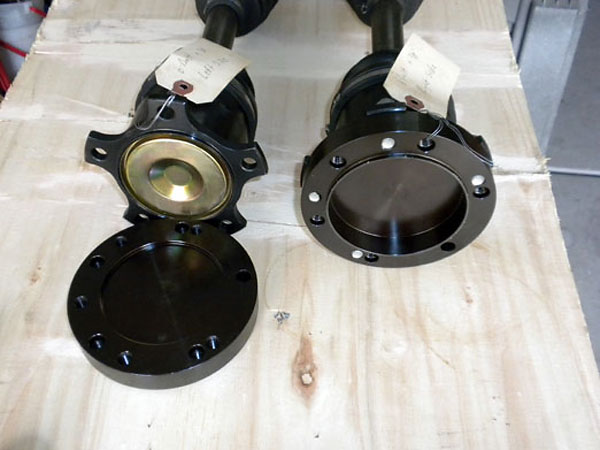
These CV joints have 5-bolt flanges, so Calvin needed to use adapters to mate to his 6-bolt
Nissan rear end. End result: nine bolts per axle and shorter axle shafts. Since Calvin is
using disc brakes instead of drums, the mounting difference figured into length
calculations too. (Shafts need to be about 3/8" longer per for disc brakes.)
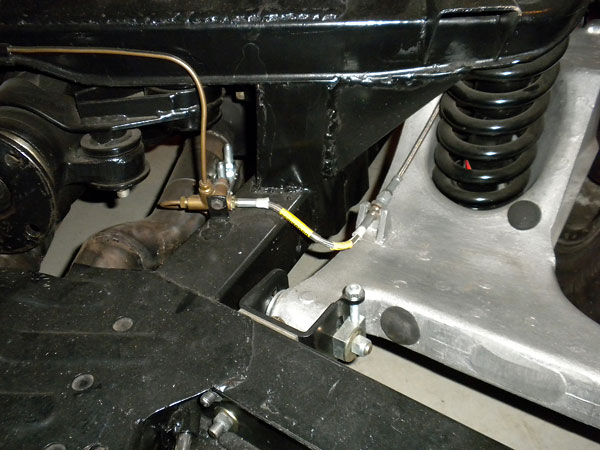
Calvin initially set the car up with 450#/inch rear springs (shown here), but he has recently
updated the rear suspension with 600#/inch springs supplied by Richard Good at Good Parts.
The stiffer springs have cured the car's tendency to squat deeply on acceleration.
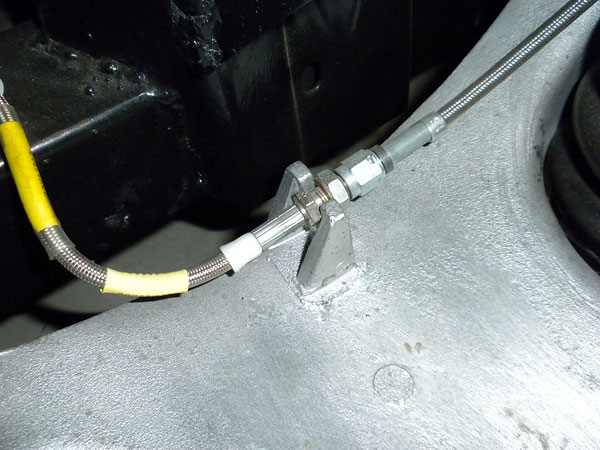
Stainless steel braid covered brake lines.
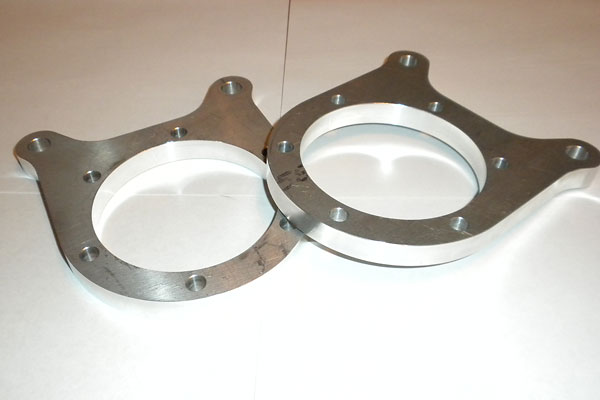
Don Watson supplied brake caliper mounting brackets.
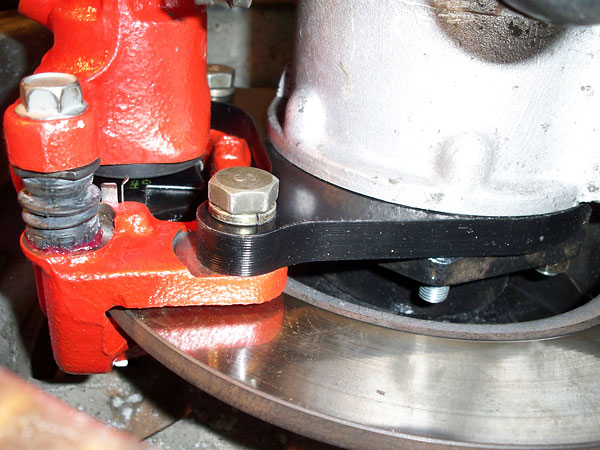
1987 Nissan Maxima brake calipers used in combination with 1992 Nissan 240SX rotors.
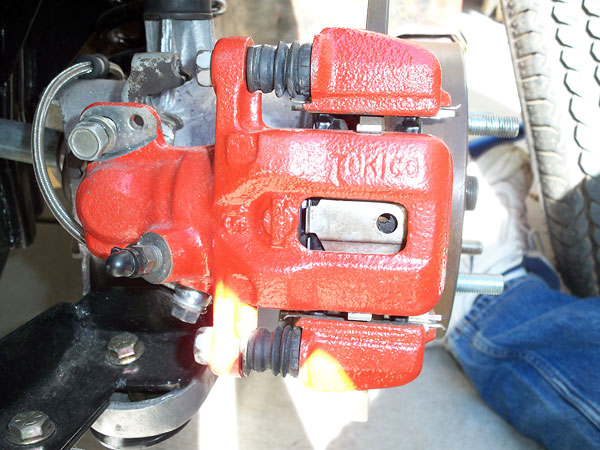
There are two styles of brake caliper for a 1987 Maxima. The change occured in March of
that year, and the earlier design has fewer internal parts. This difference should only
matter if you decide to rebuild a set of these calipers yourself.
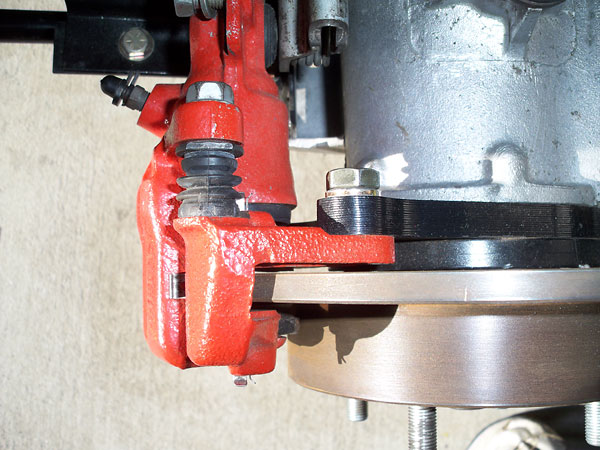
The Nissan 240SX brake rotors require a very minimal modification: the inner hole
that goes over the hub will need to be machined out ~0.068". Pretty much anyone
with a metal lathe should be able to to make this change in short order.
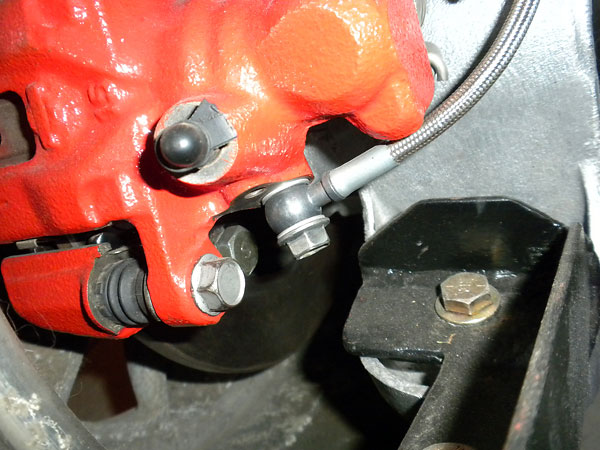
The bleeder screw on the caliper isn't ideally positioned. To bleed the brakes fully,
remove the calipers and temporarily position them so that the bleeder is pointed
upward. Put a spacer between the pads that's about the same thickness as a rotor.
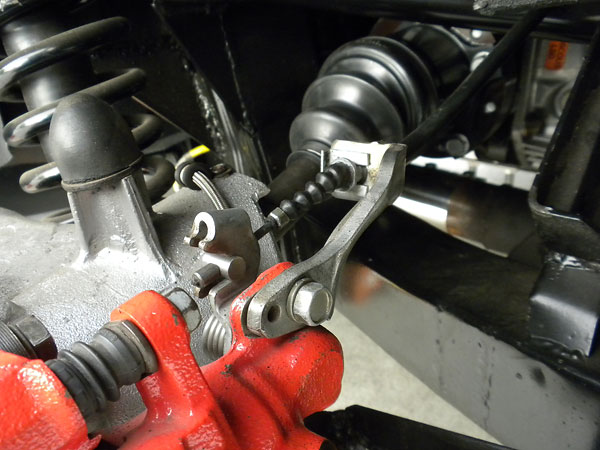
When first installed, the emergency brake cable brackets on the Maxima calipers were
pointed upward. Calvin found that the cable brackets on old 240SX calipers will
install on the Maxima calipers and solve this problem. Now, the emergency brake
cables point toward the differential.
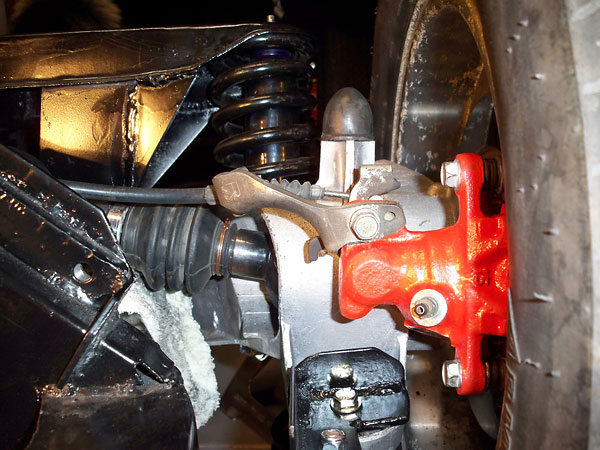
Want to know more? How To Upgrade your Triumph TR6 with Rear Disc Brakes
Interior Trim
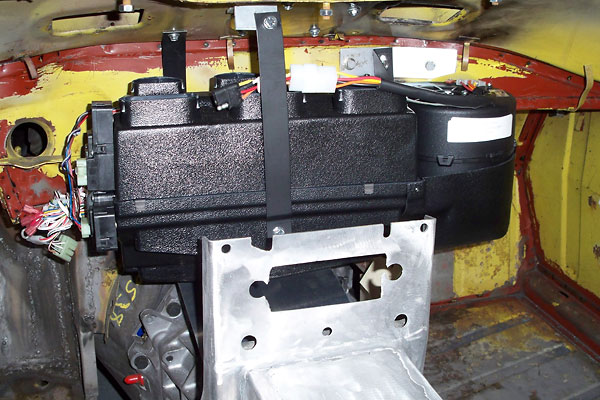
Vintage Air Mini II heater and AC evaporator unit, mounted in place. Notice that,
its position will require relocation of the radio downward. The new electric HVAC
control panel will be mounted into the original heater control area.
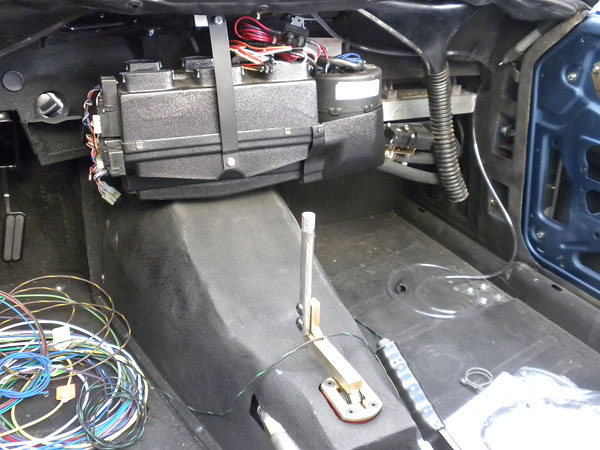
Specially fabricated aluminum transmission cover.
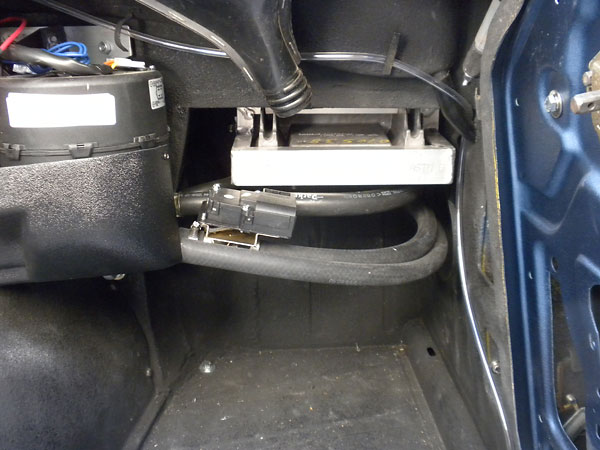
Engine computer.
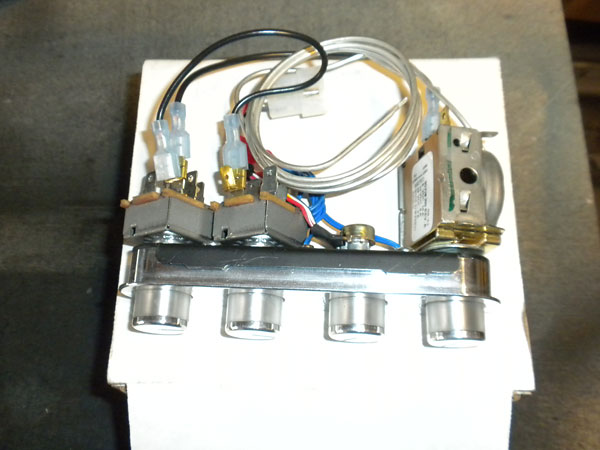
Vintage Air Mini air/heat/defrost control panel.
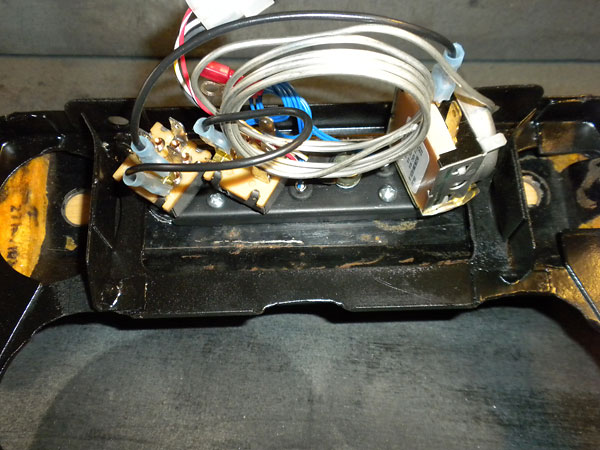
HVAC controls, viewed from the rear.
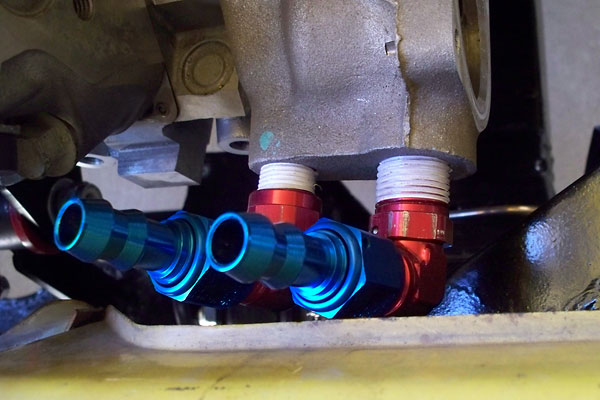
Heater hose connections on the water pump.
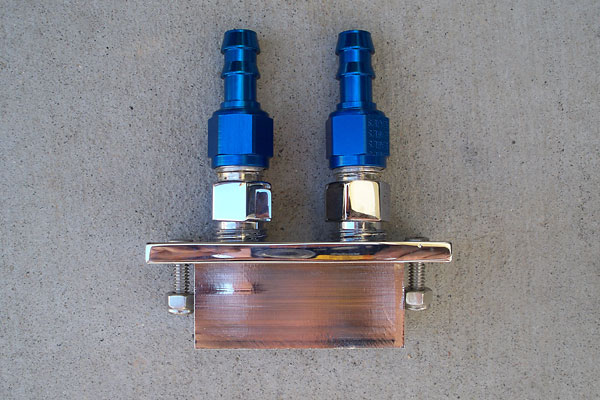
Heater hose bulkhead pass-through.
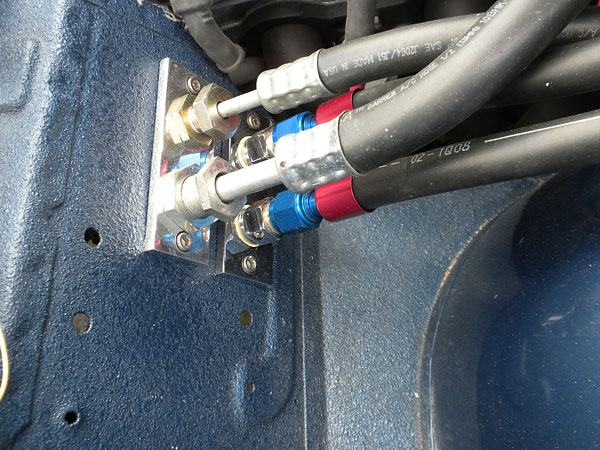
Air conditioning line and heater hose pass-throughs, installed.
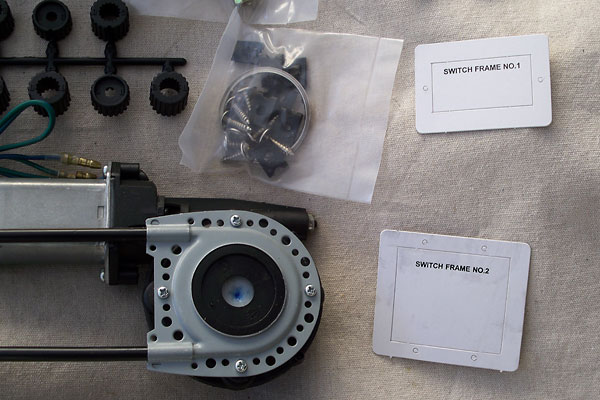
SPAL Deluxe power window kit - electric motor.
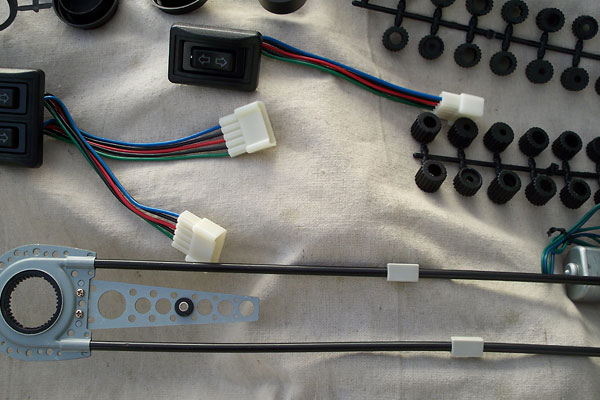
SPAL Deluxe power window kit - cable drive system.
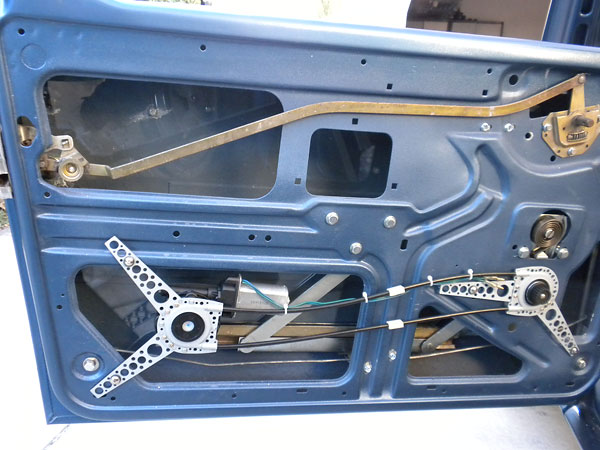
Mounting the SPAL power window kit in a Triumph TR6 door.
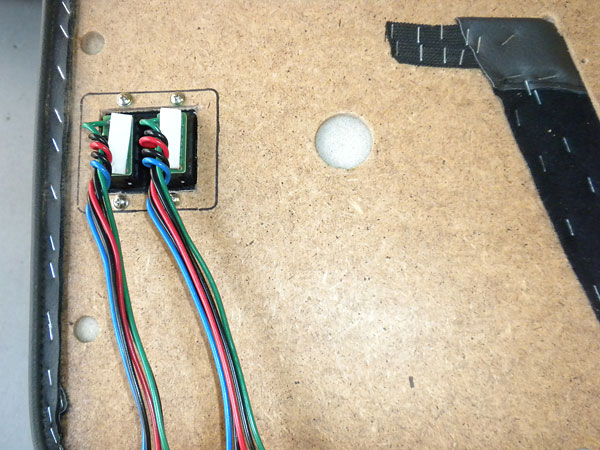
Power window switches mounted in the driver side door card.
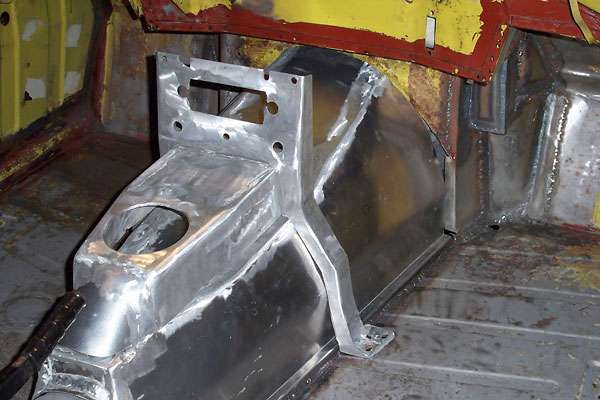
Custom fabricated aluminum Triumph TR6 transmission cover and center console.
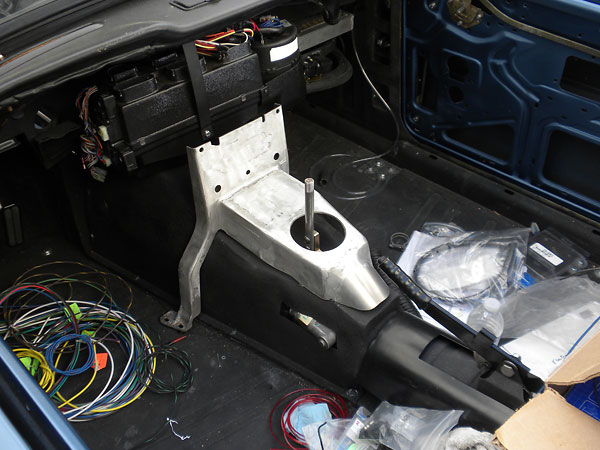
Installing the HVAC system and behind-the-dashboard wiring.
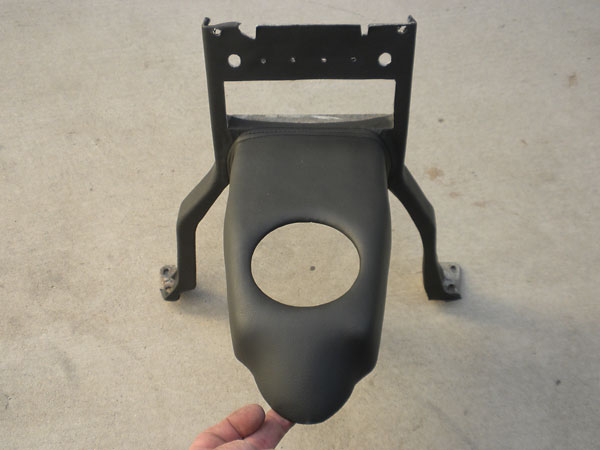
Upholstery wrapped center console.
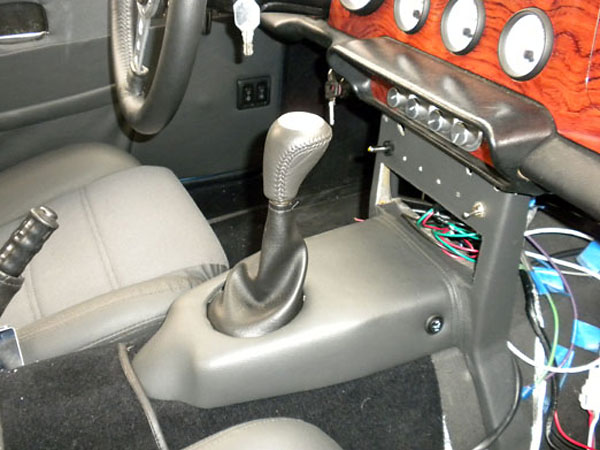
Switches on the side surface of the center console are for electric seat heaters.
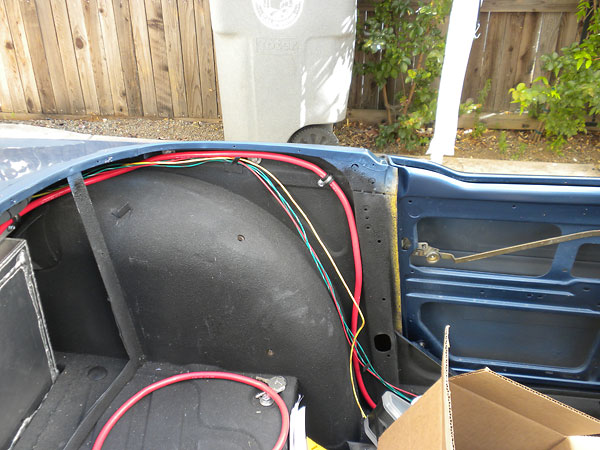
Cable routing.
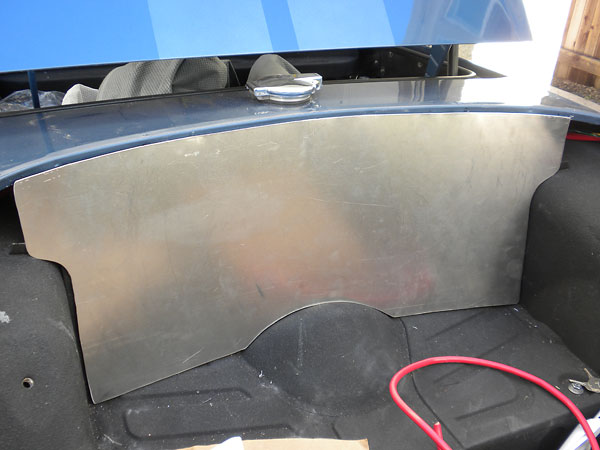
Thin aluminum firewall between fuel tank and passenger compartment.
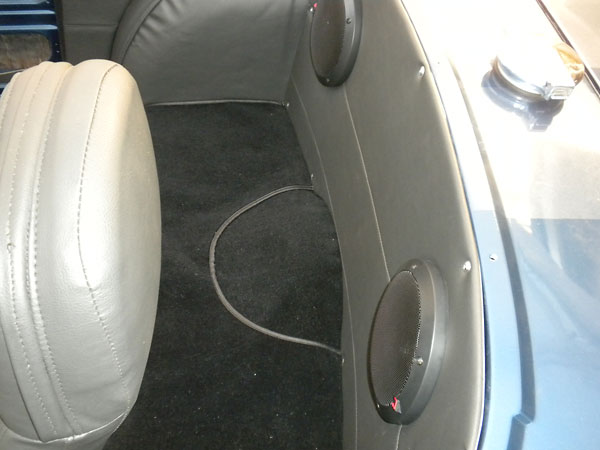
Rear speaker installation in the aluminum firewall.
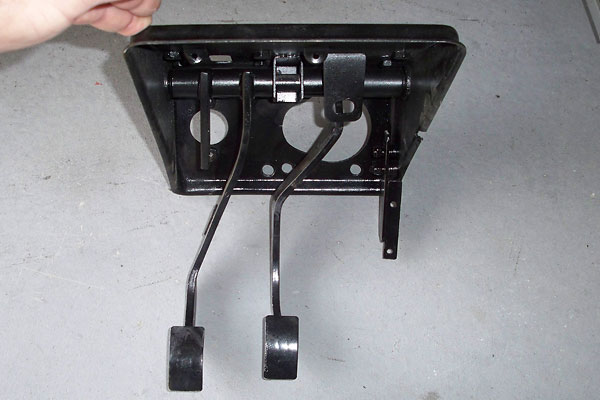
Modified Triumph TR6 pedal assembly with brake master cylinder shifted outboard 3/4" to make room
to package the steering shaft between the power brake booster and the LS1's driver-side valve cover.
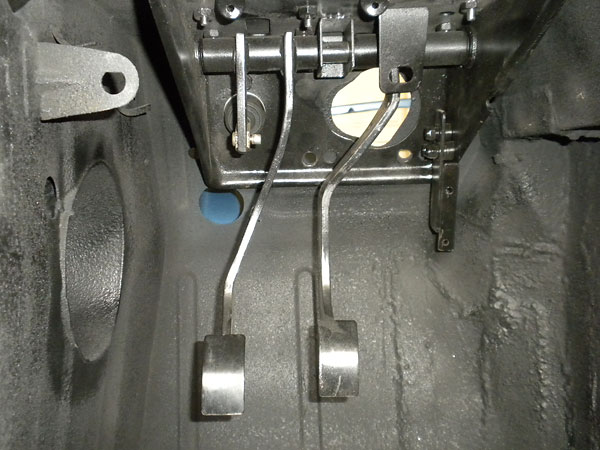
Brake and clutch pedals have been shifted just a little bit to the left.
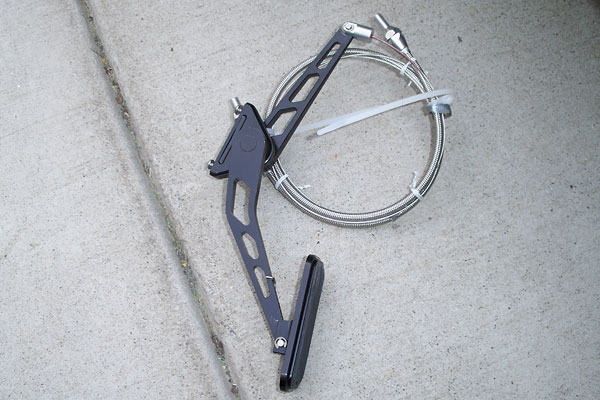
New cable-operated throttle pedal assembly.
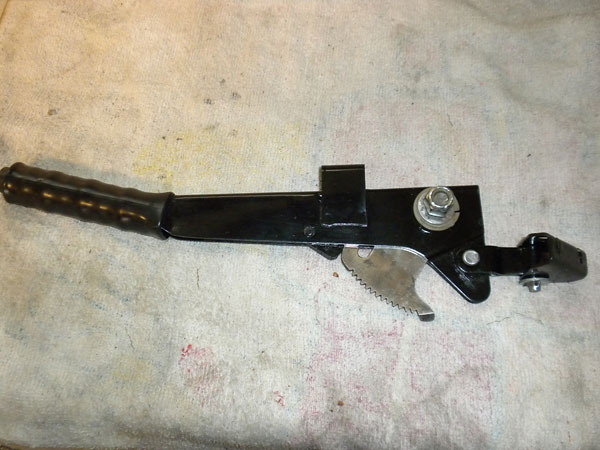
Restored parking brake lever. (A heat gun was used to remove and replace the grip.)
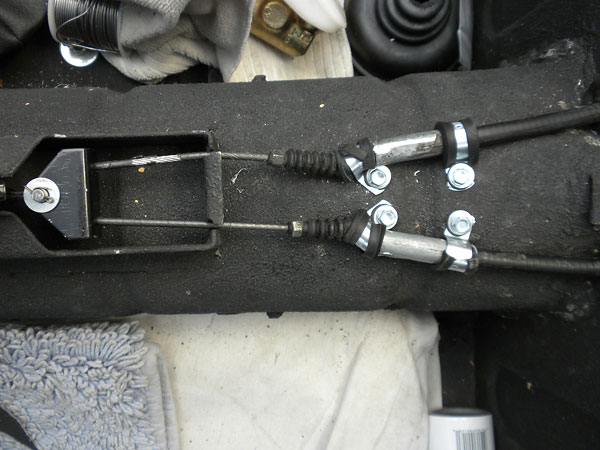
Nissan 240SX parking brake cables, connected to the Triumph TR6 lever and bracketry.
Interior
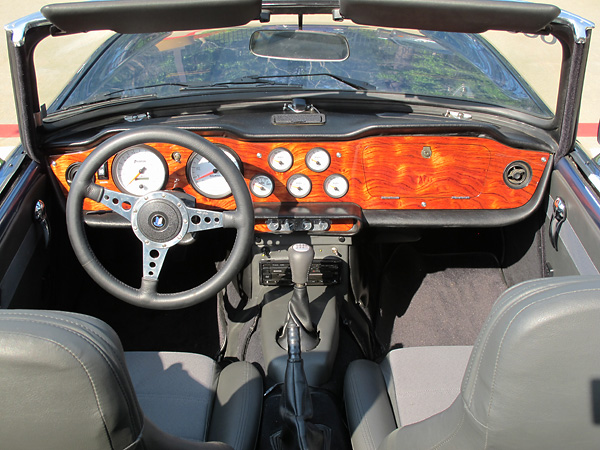
Custom dashboard made from Kewazinga African rosewood by Randy Keller of Prestige Autowood.
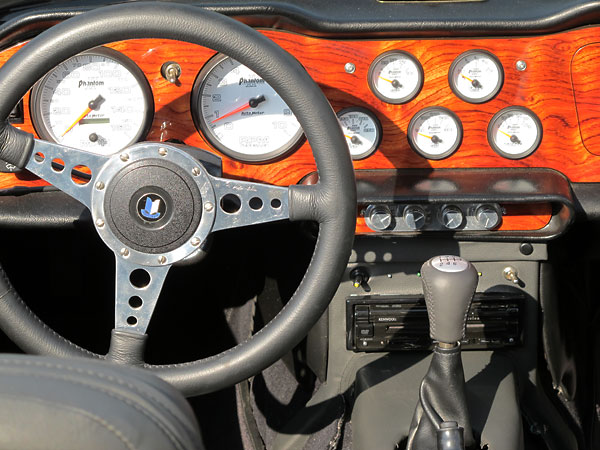
Leather wrapped Moto-Lita steering wheel.
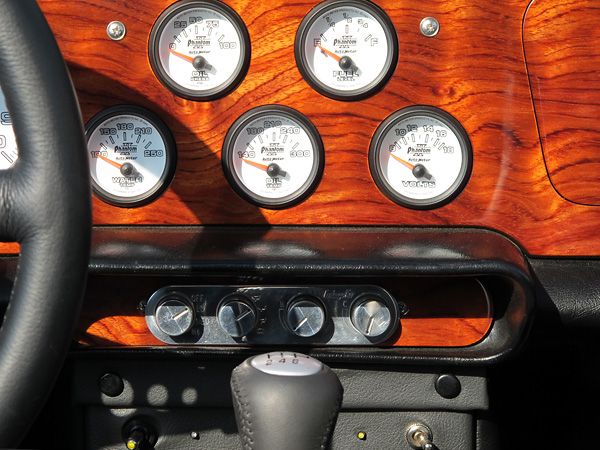
AutoMeter Phantom II digital gauges (set of 7).
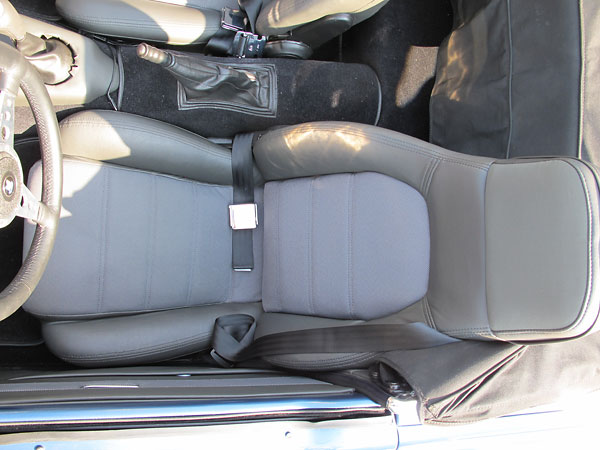
Early Mazda Miata seats with upgraded speakers in headrests and
with both upper and lower cushion electric seat heaters.
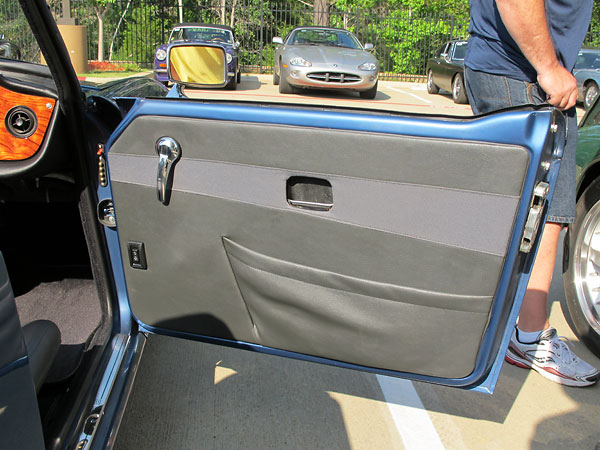
Custom upholstered door panels.
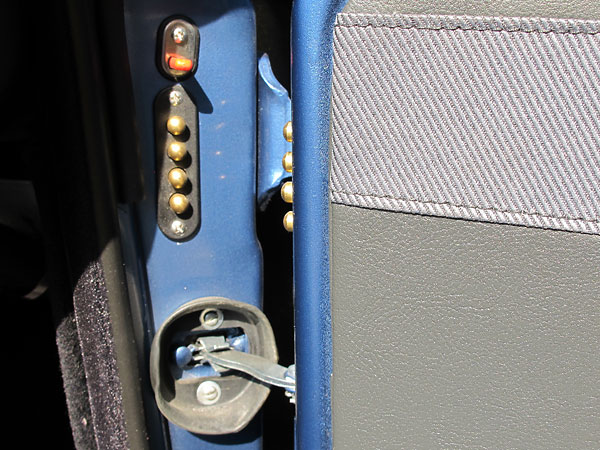
Four-pin electrical contact strips at the door jams for electric window circuits.
Enjoying this article? Our magazine is funded through the generous support of readers like you!
To contribute to our operating budget, please click here and follow the instructions.
(Suggested contribution is twenty bucks per year. Feel free to give more!)
Bodywork and Paint
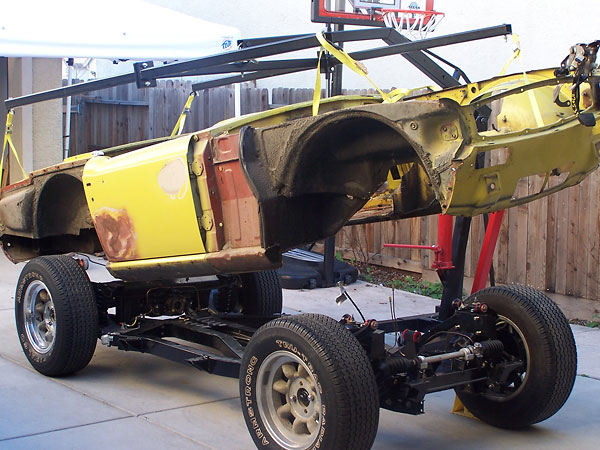
Modified hydraulic engine hoist and adapter frame for lifting/lowering the car's body.
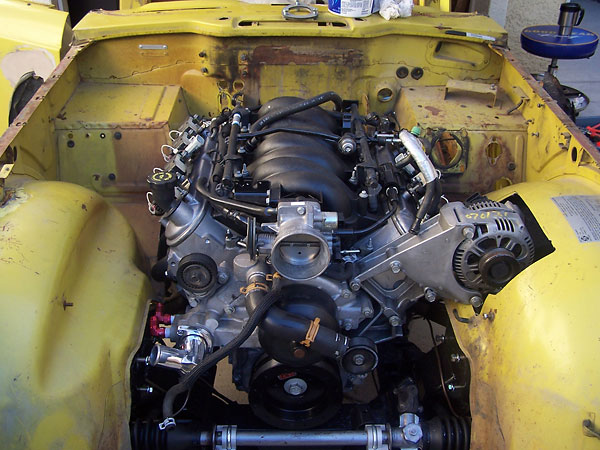
A couple Sawzall cuts are sometimes needed rather early on in a project.
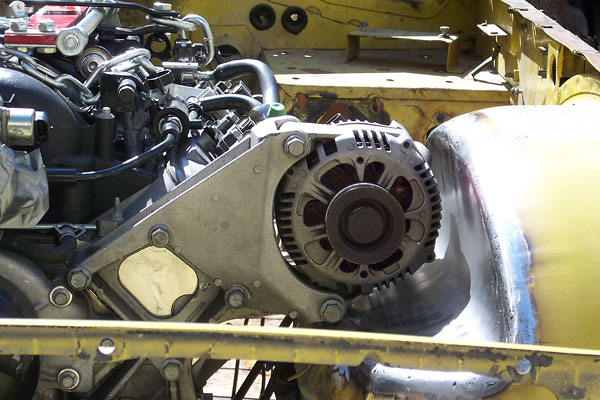
Having pieces in place can make it easier to come up with elegant bodywork solutions.
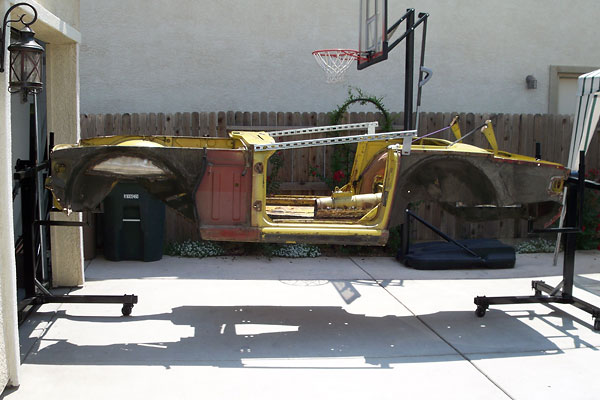
Calvin's home-made rotisserie.
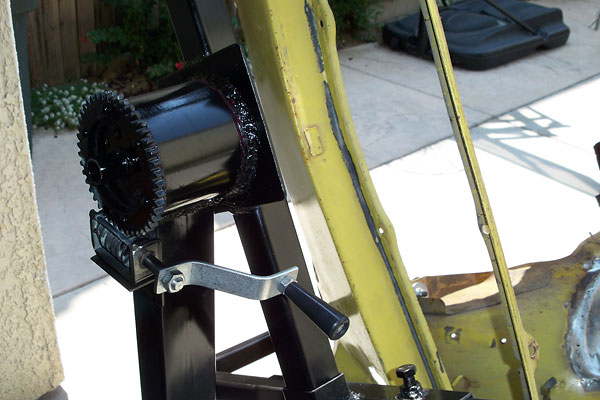
(Instructions for building a similar rotisserie can be found by clicking here.)
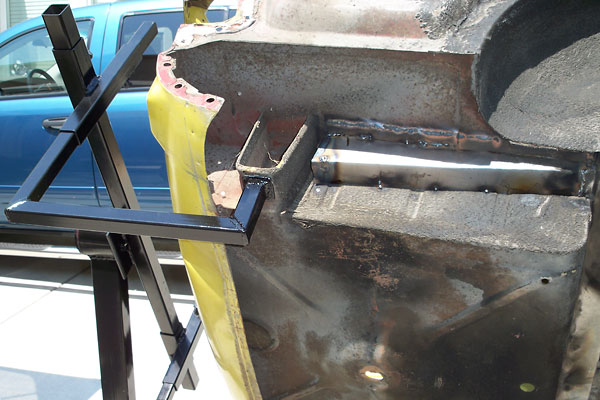
This view shows from the outside how Calvin modified his trunk floor so a
generously sized fuel tank can be slid into and out of position inside.
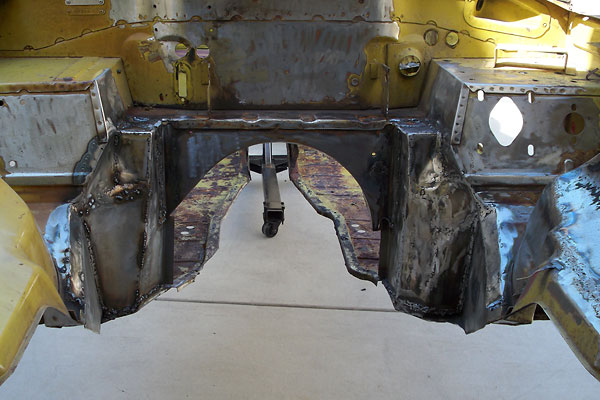
The firewall section that sits closest to the transmission bellhousing has been cut out
and shifter rearward far enough that the engine and transmission can be installed as a
bolted together unit. The original battery location is therefore no longer viable.
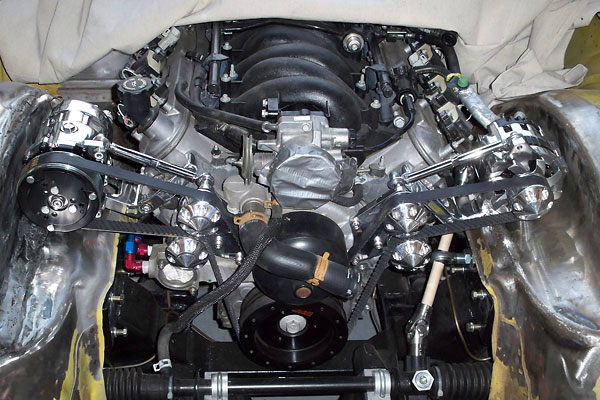
This photo shows a trial installation of the then-new Front Runner serpentine-belt accessory
drive system. There wasn't as much clearance on the air conditionion compressor side as
anticipated, so Calvin ended up cutting out that bodywork and re-doing it. (See next photo.)
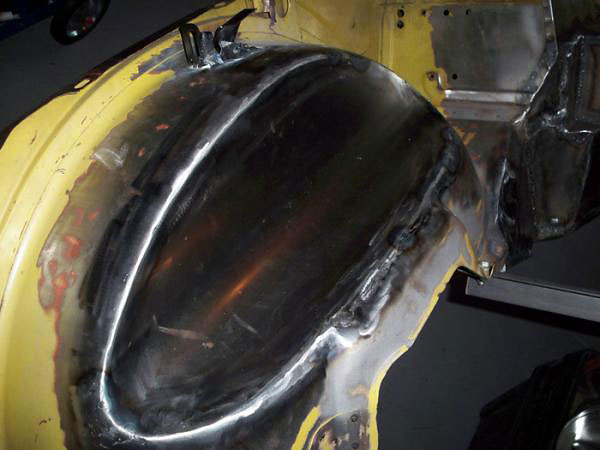
Here's Calvin's second and much improved passenger-side inner fender modification. Halfway
through this project, Calvin bought a Miller Diversion 165 TIG welder. He found it easy to
use and that it dramatically improved his welding results. Less warpage. Less clean-up.
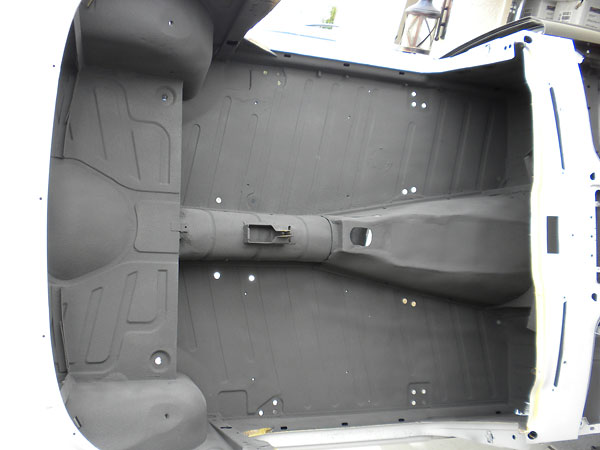
Lizard Skin spray-on sound control and ceramic insulation were applied to both interior and
exterior surfaces of just about every little part of the body except for the shiniest ones.
The company that markets Lizard Skin (Mascoat) claims it can reduce sound transfer by
twelve decibels or more and also engine and solar heat transfer by 30°F or more.
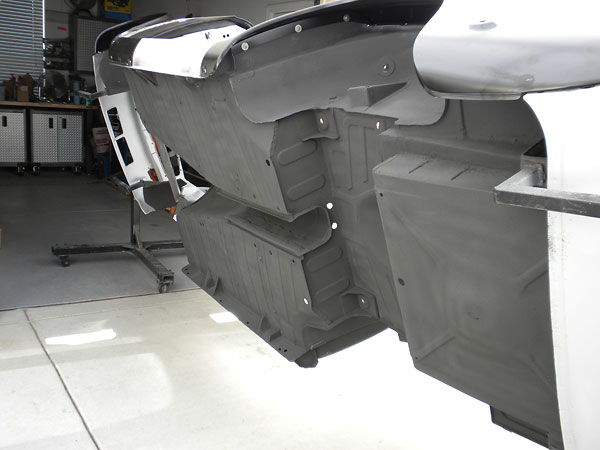
The Lizard Skin sound control product must be applied first, before their ceramic heat control
coating. Calvin strongly recommends buying Lizard Skin's own special sprayer kit for the job.
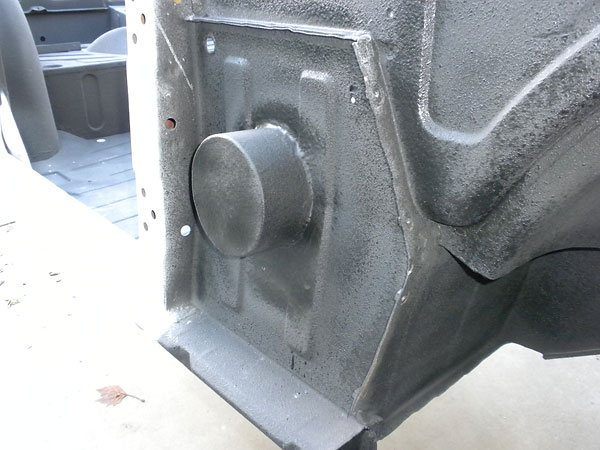
Footbox area speaker enclosure, viewed from outside.
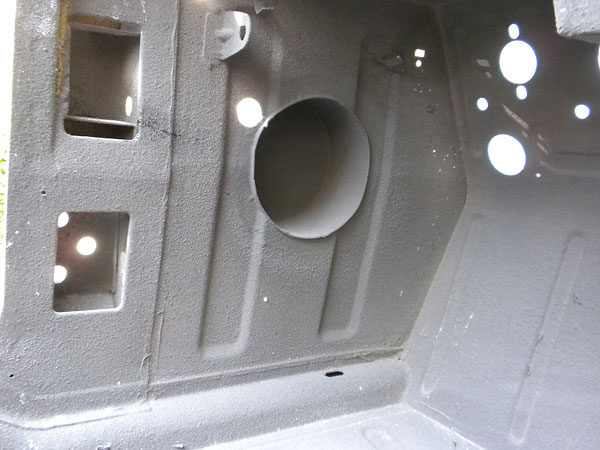
Footbox area speaker enclosure, viewed from inside.
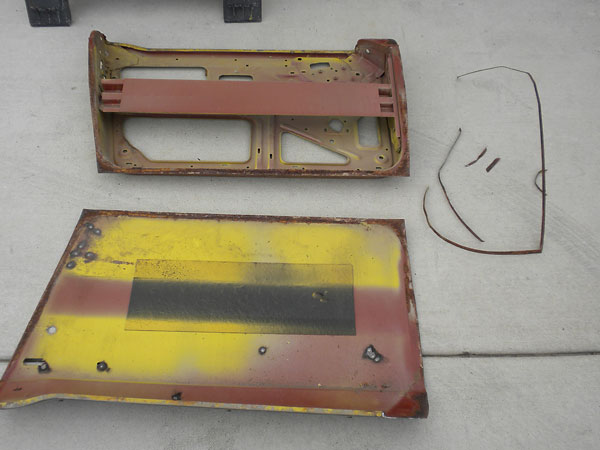
Removing an old, damaged door skin: the very edge is carefully ground away with a
side grinder and then the folded-over lip comes free and can be set aside.
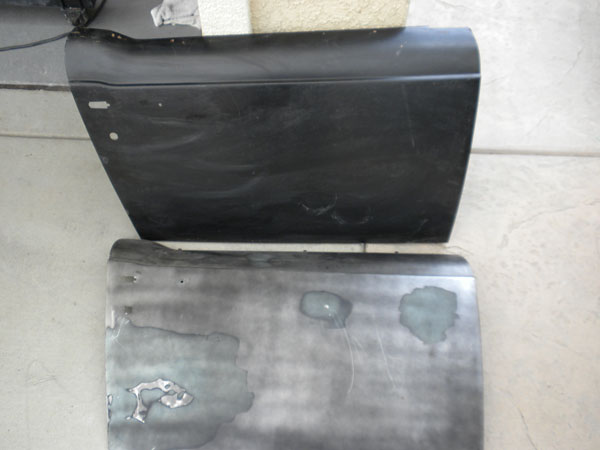
A replacement door skin, pre-primed black, is shown here ready to install.
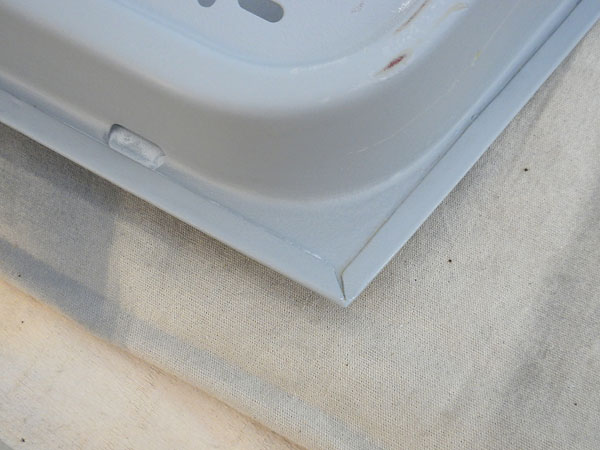
The new door skin is folded over and crimped tight down to the inner door assembly.
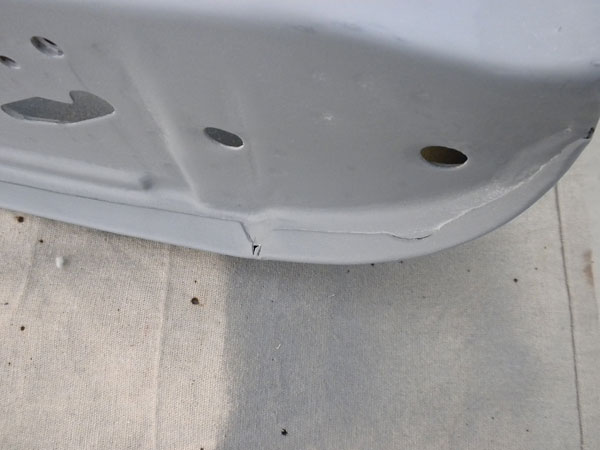
This is hammer and dolly work. The curved sections take a bit of finesse.
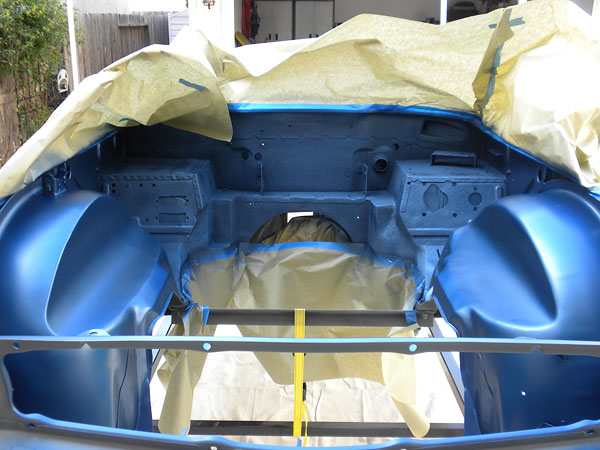
Finally, base coat paint has been applied to the engine compartment. Toward the rear,
you can see the textured surface where Lizard Skin was applied before the color coat.
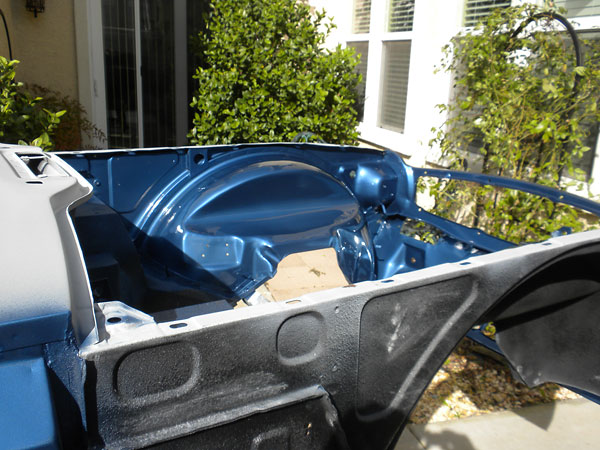
There's just a little bit of pearl mixed into this paint, but
the light is right in this view to bring out the effect.
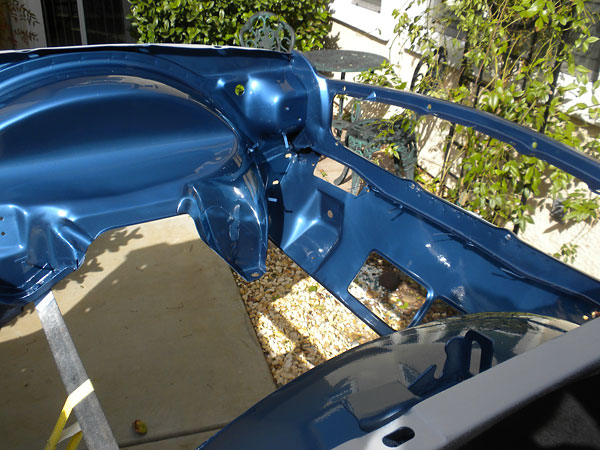
A detail spray gun and great care are required to do a nice job like this.
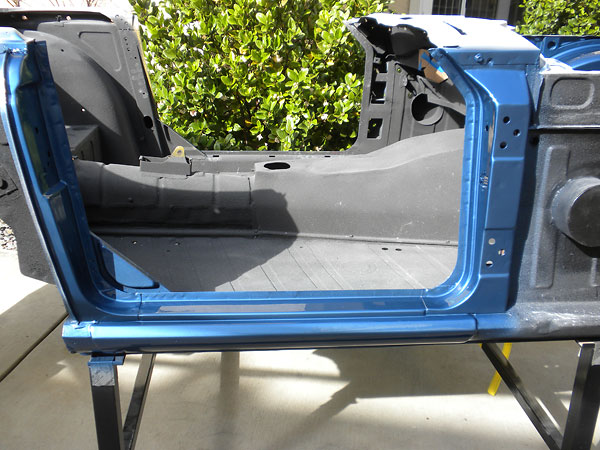
Don't take shortcuts when painting door jams. Quality really shows here.
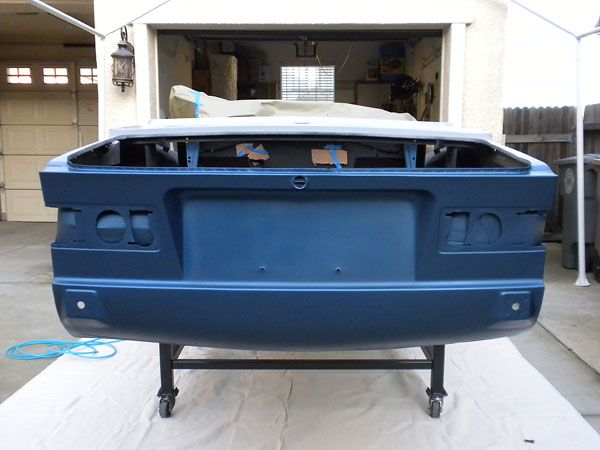
Should the rear of a Triumph TR6 be painted body color?
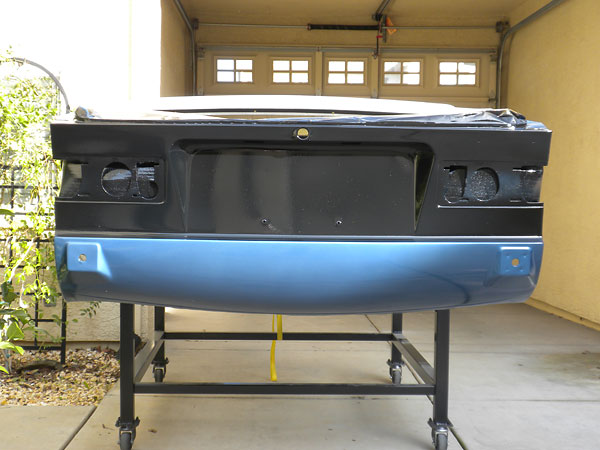
Calvin and Brenda looked at a lot of TR6s and decided they prefer gloss black.
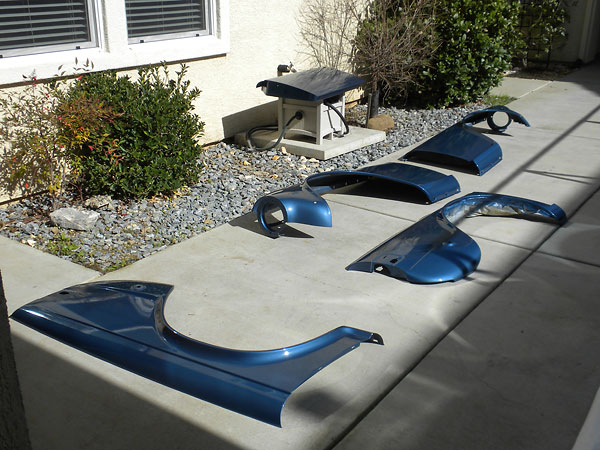
Painting individual panels off-the-car isn't so hard. Getting them all installed
and properly aligned will be another story.
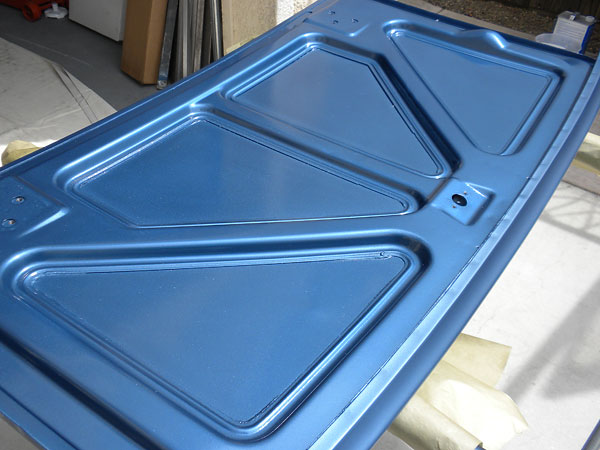
Boot lid.
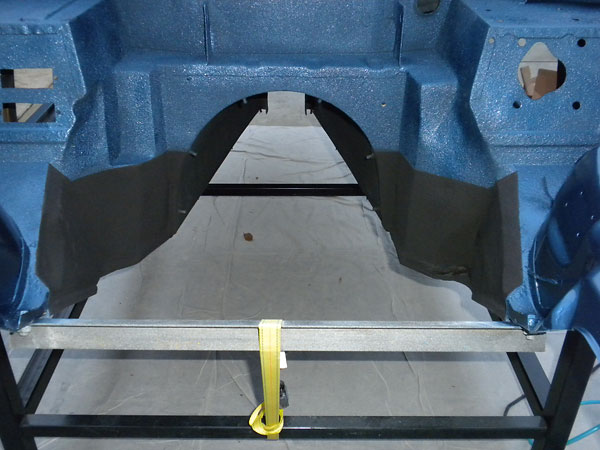
Curious about what Lizard Skin weighs? The sound control product weighs 26.6 lbs per two gallon
pale, and covers ~100 square feet. The insulation product weighs 11.8 lbs per two gallon pale
and covers 40 to 70 square feet. It could easily add thirty to forty pounds to your car.
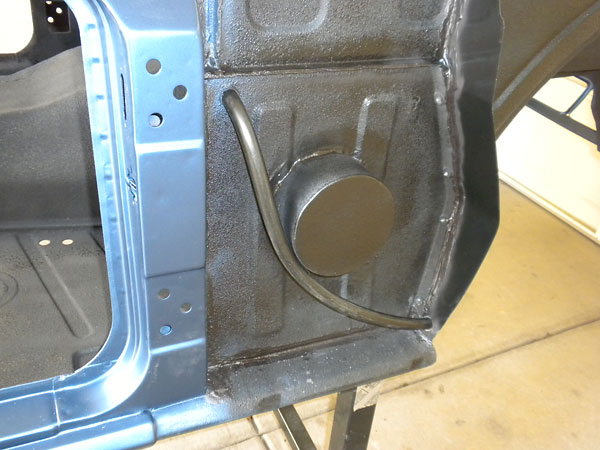
Calvin added a rubber drain tube on both sides. On a stock TR6, water
simply drips through a vent from the cowl area down onto the inner sill.
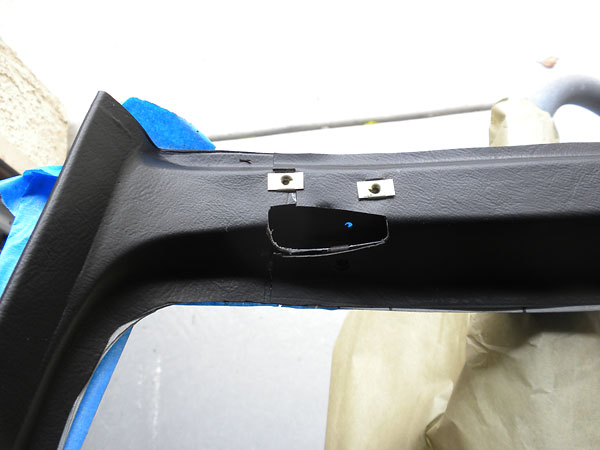
The inboard surfaces of the TR6 windshield surround are covered with
pre-formed vinyl that's held on with strong 3M spray adhesive.
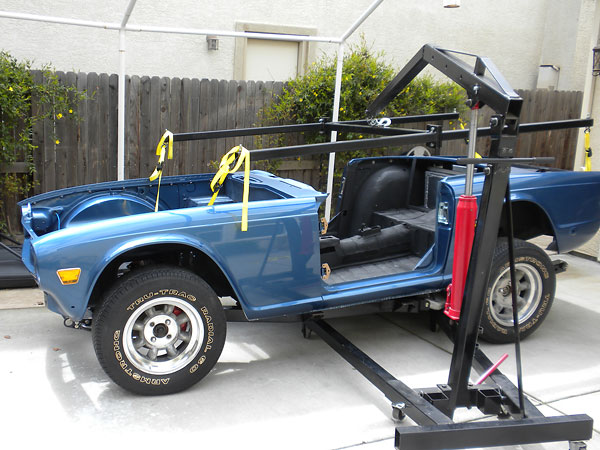
Careful, now!
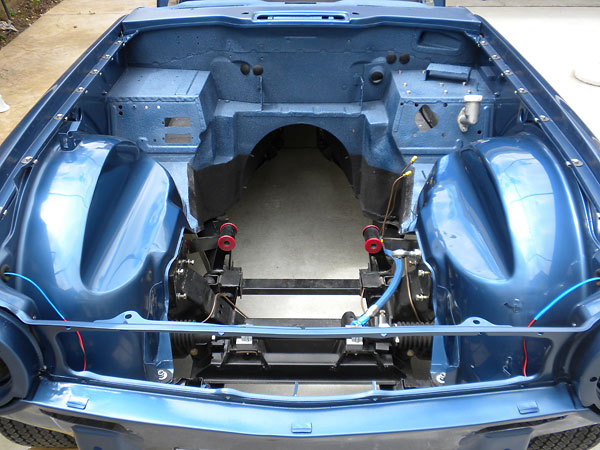
Comparing the two modified inner fenders, the drivers side was done with a MIG welder
whereas the passenger side was done with a TIG welder. The TIG welder transfers less
heat out into the sheetmetal and therefore causes less warpage.
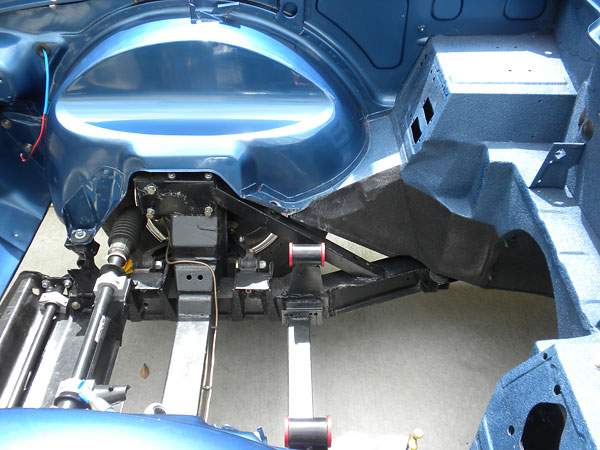
The black paint at right is high-temperature rated. (It will be closer to the exhaust.)
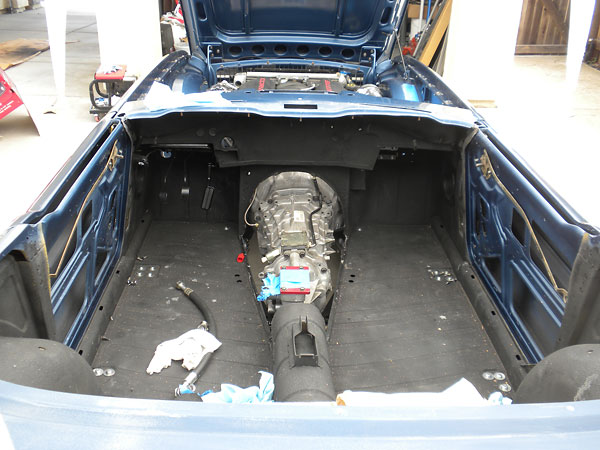
With the newly painted body bolted down, final assembly will move along quickly.
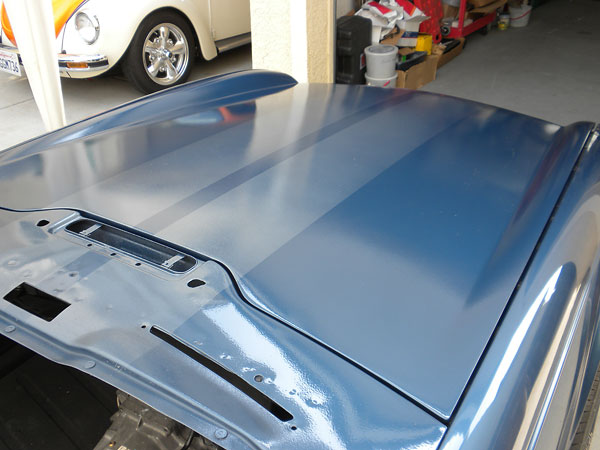
PPG Atlantic Pearl Blue two stage paint with white pearl ghost stripes. The ghost stripes are base
paint but with no (blue) tint; white pearl was mixed-in instead. They're painted overtop two coats
of the regular (blue) base coat, and then two coats of clear coat were applied over everything.
Exterior
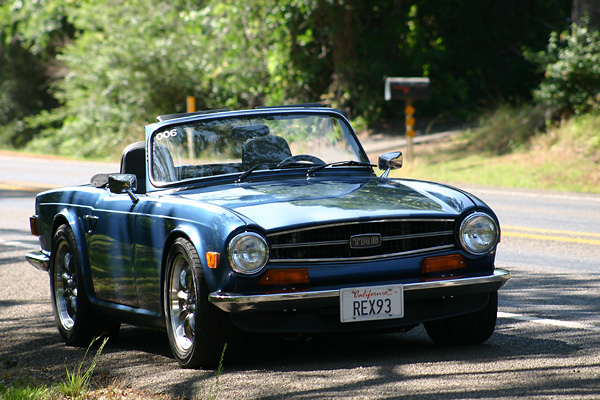
Calvin's exceptional Triumph TR6 V8 project was journaled in this message board thread.
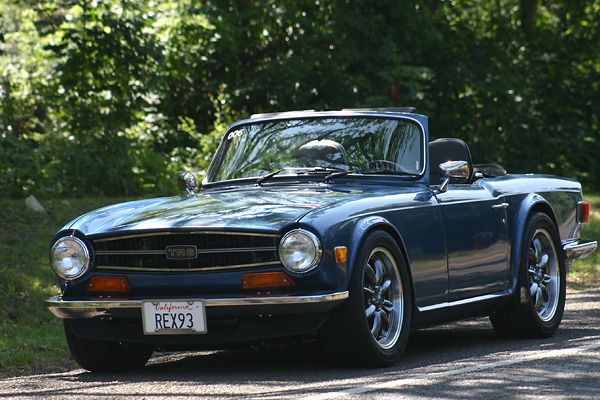
The British call this a "Q car". Nothing on the outside hints at what's hidden inside.
Who would guess that this Triumph TR6 puts over 400 horsepower to the ground?
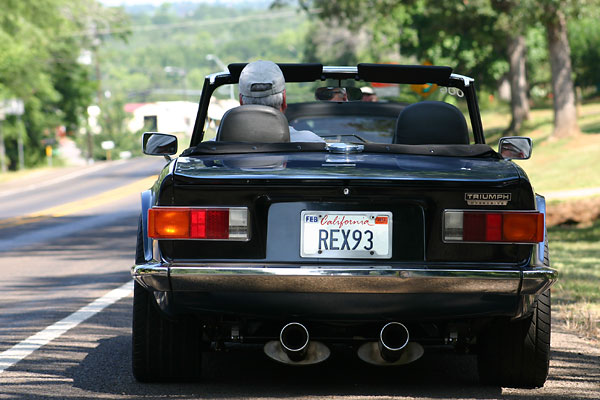
Okay, maybe dual Monza 2.5"-to-4" glass-pack tailpipe tips are a subtle clue.
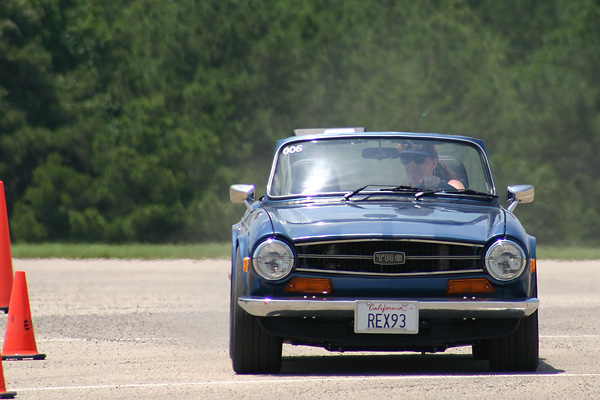
Brenda showed tremendous natural talent during the BritishV8 2012 autocross.
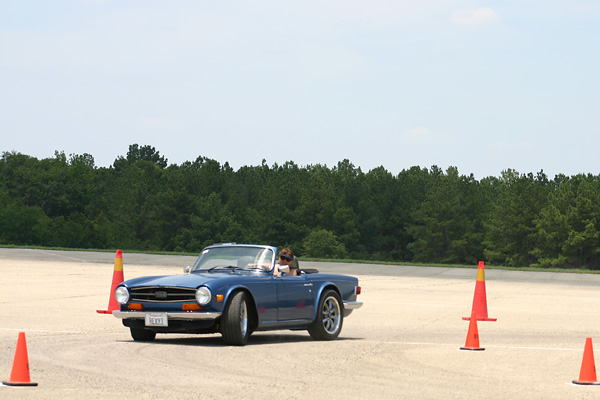
Smooth and fast at the same time.
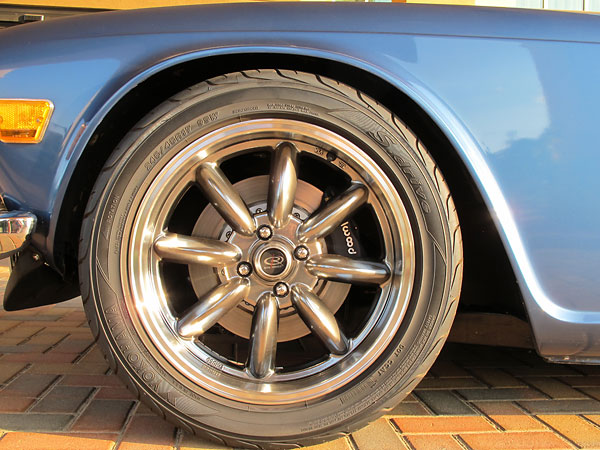
Rota RB Hyper Black aluminum wheels (17x7.5, 4-100mm lug spacing, +45mm offset).
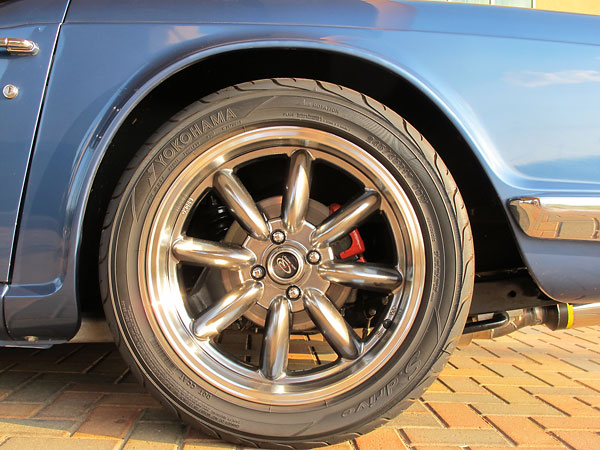
Yokohama S-drive w-rated 245/45R17 tires (~10" wide).
Generally, photos showing the course of this project are by Calvin Grannis. Photos by Calvin have three-letter codes in their file names. Photos showing the completed project are by Curtis Jacobson. Photos by Curtis have two-digit codes in their names. The two action photos (above) were taken during the BritishV8 2012 autocross by Jim Watson. All the photos are copyright protected. Please contact BritishV8 to arrange permission before reproduction.



